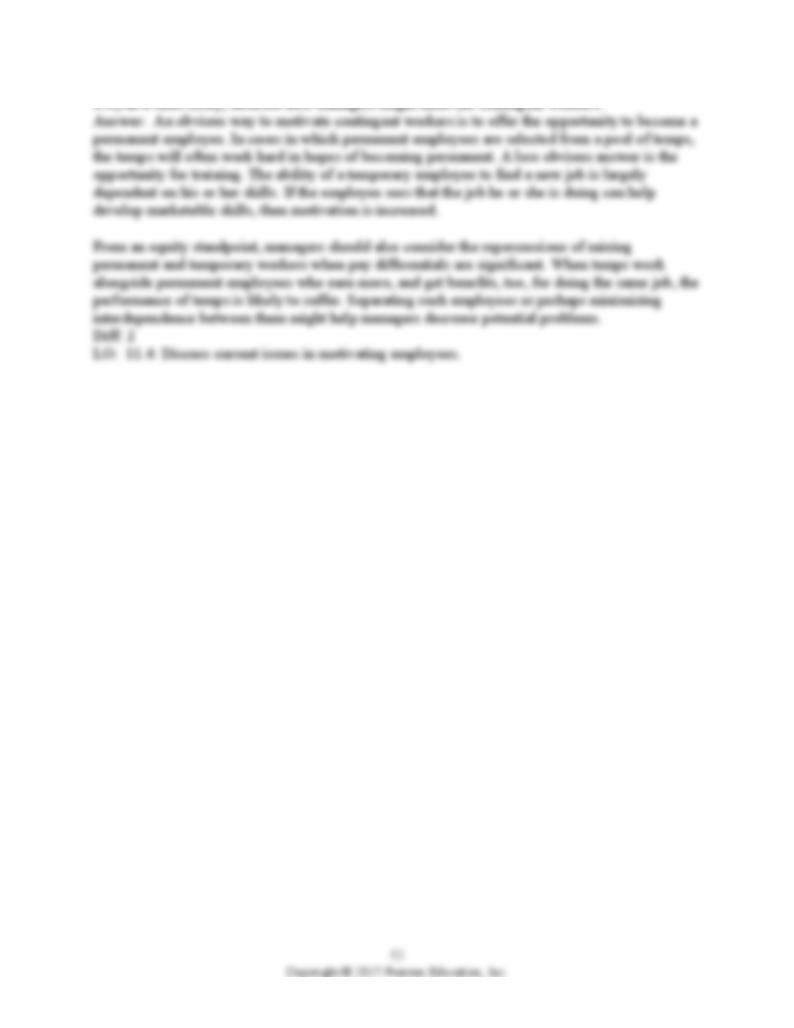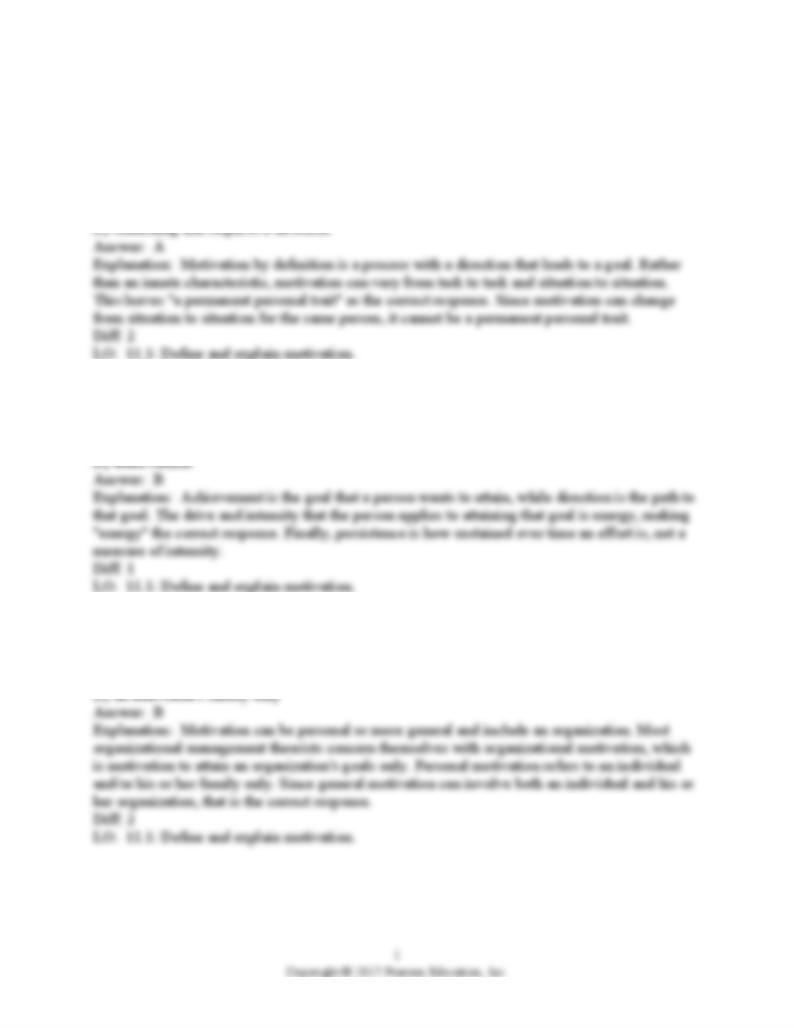
Fundamentals of Management, 10e (Robbins)
Chapter 11 Motivating and Rewarding Employees
1) Motivation is NOT ________.
A) a permanent personal trait
B) a process that leads to a goal
C) something that varies from situation to situation
2) Which element of motivation is a measure of intensity or drive?
A) direction
B) energy
C) persistence
3) The direction of an individual's motivation can be channeled to benefit ________.
A) only an organization
B) both individuals and/or organizations
C) only an individual
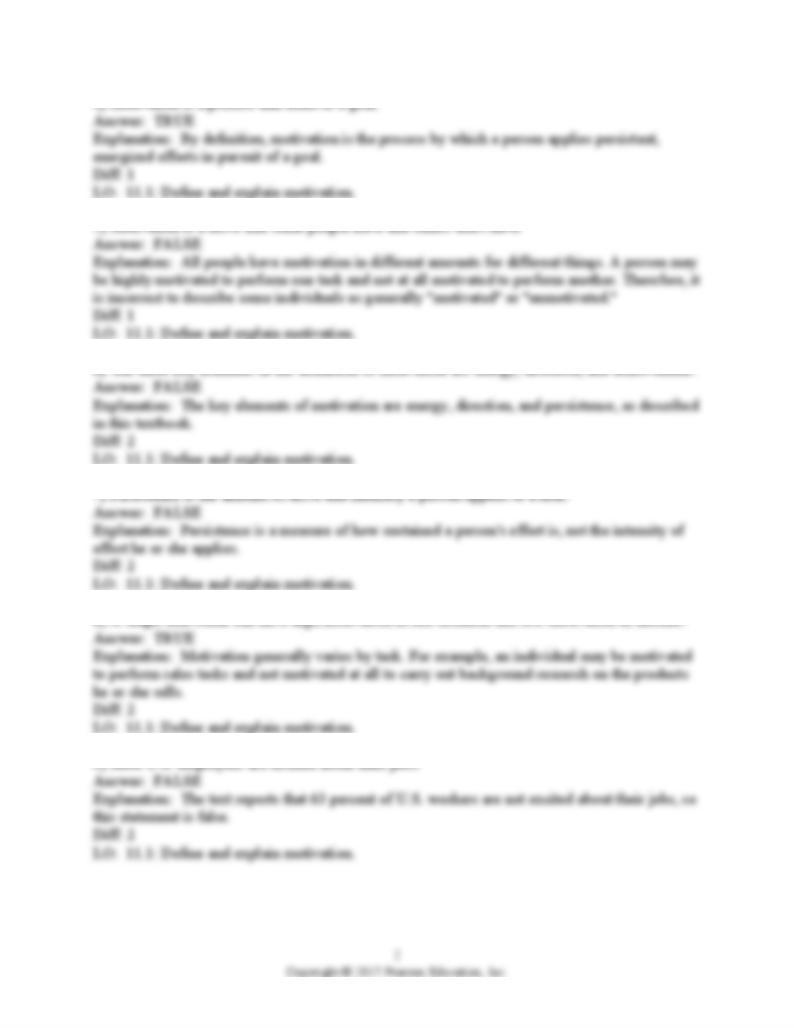
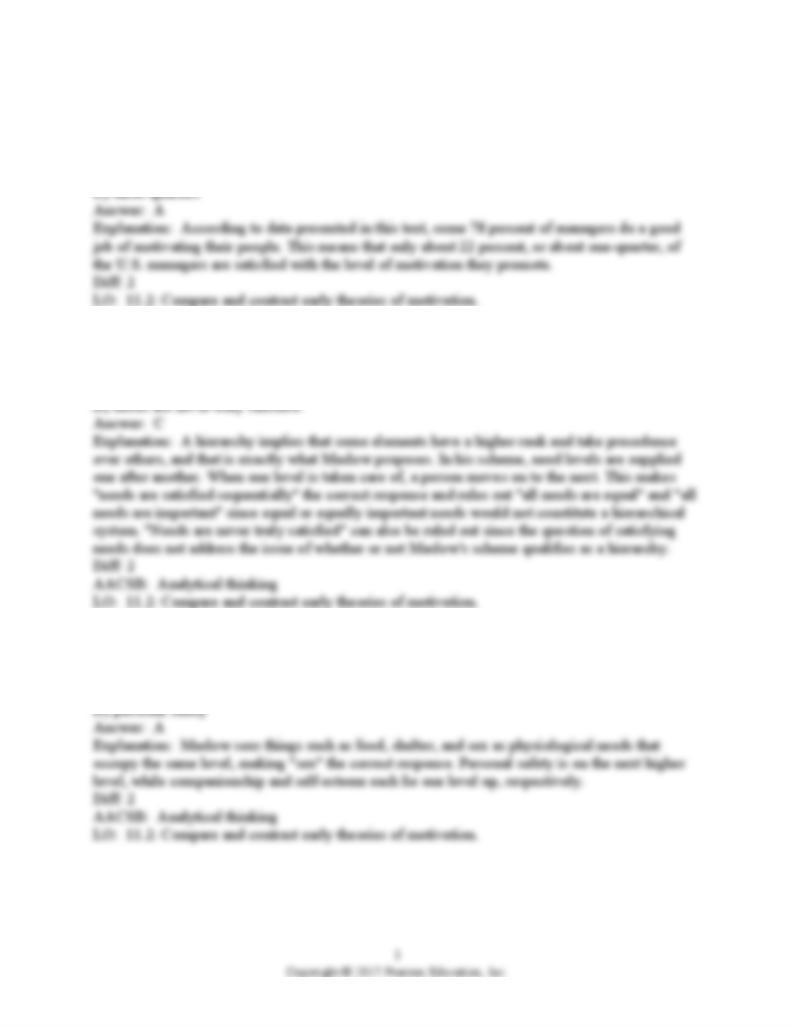
10) About ________ of managers surveyed feel they do a good job of motivating their
employees.
A) one-quarter
B) one-half
C) a little over half
11) Maslow's theory is a hierarchy because ________.
A) all needs are equal
B) all needs are important
C) needs are satisfied sequentially
12) Maslow sees food as being on the same level of need as which of the following?
A) sex
B) companionship
C) self-esteem

13) According to Maslow, a person stranded on a desert island would ________ before he or she
worried about making weapons.
A) look for other people
B) build a house
C) start a family
14) An individual who wants to buy a home in a neighborhood with a low crime rate is satisfying
which need?
A) esteem
B) safety
C) physiological
15) Maslow argued that once a need is substantially satisfied, ________.
A) the next need becomes dominant
B) individuals no longer require that need
C) that need continues to be the primary motivation of an individual
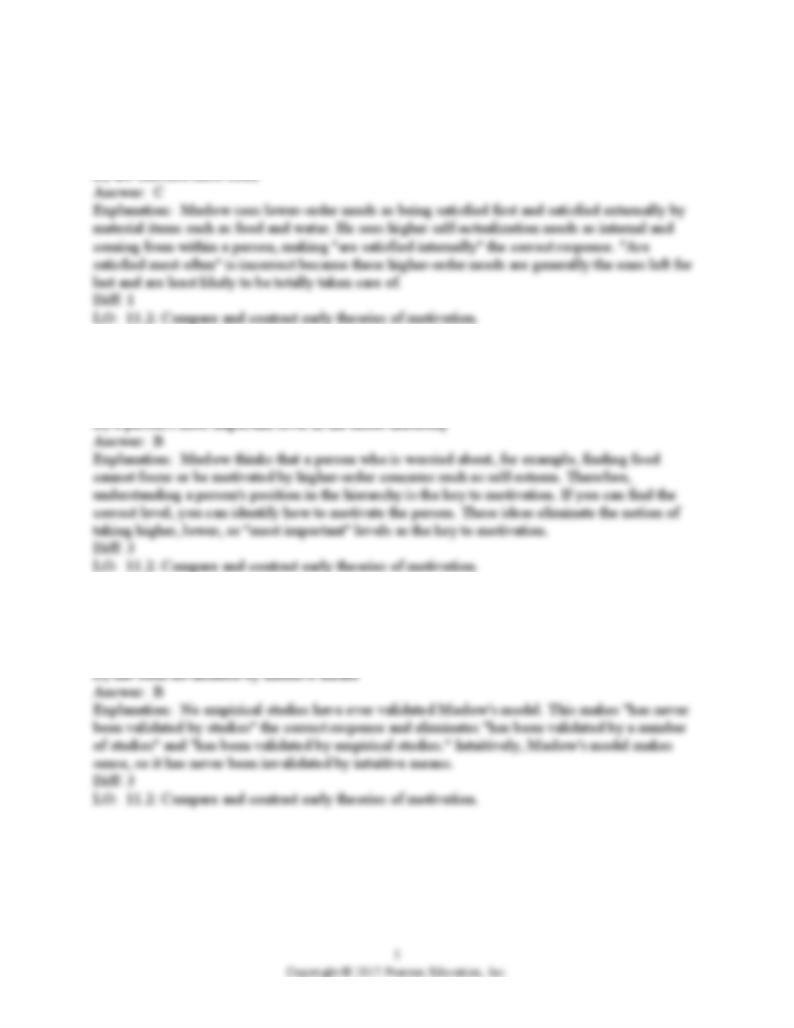
16) Maslow believes that higher-order needs ________.
A) are satisfied externally
B) are satisfied first
C) are satisfied internally
17) The key to motivation, according to Maslow, is to identify ________.
A) higher-order needs first
B) a person's level in the needs hierarchy
C) lower-order needs last
18) Maslow's hierarchical model ________.
A) has been validated by a number of studies
B) has never been validated by studies
C) has been validated by empirical studies
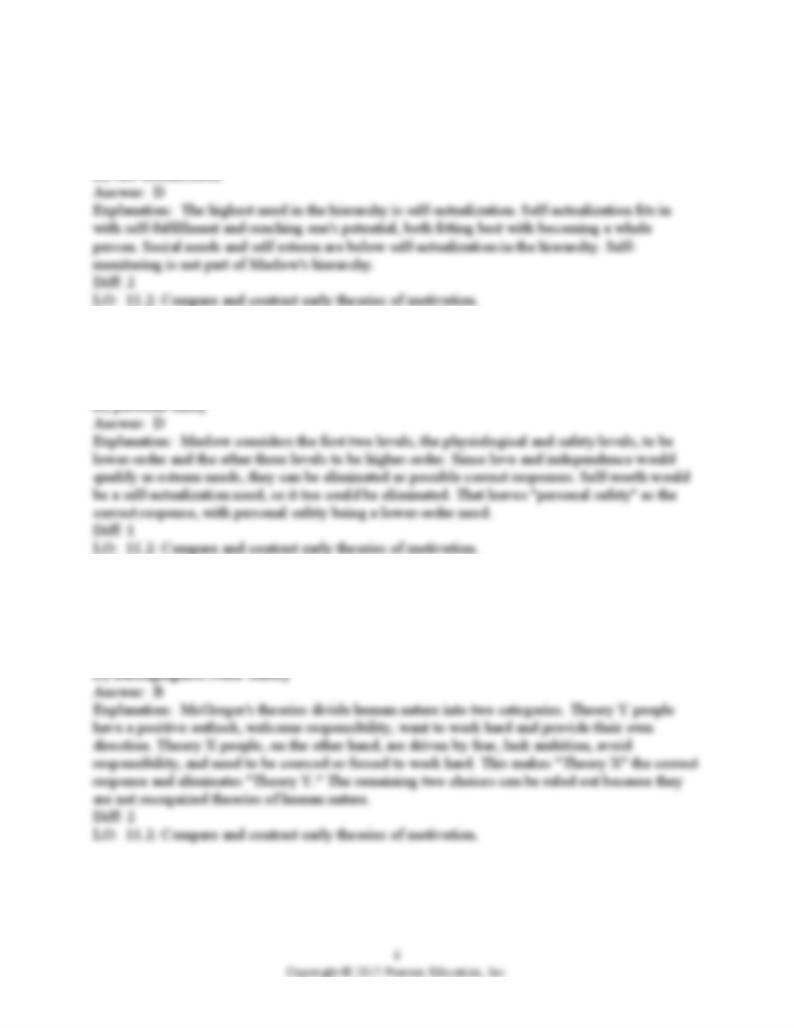
19) The highest order need in Maslow's hierarchy is ________.
A) social esteem
B) social needs
C) self-monitoring
20) Which of the following is a lower-order need in Maslow's hierarchy?
A) love
B) self-worth
C) independence
21) ________ assumes that employees have little ambition, dislike work, and avoid
responsibility.
A) Theory Y
B) Theory X
C) Self-actualization Need Theory
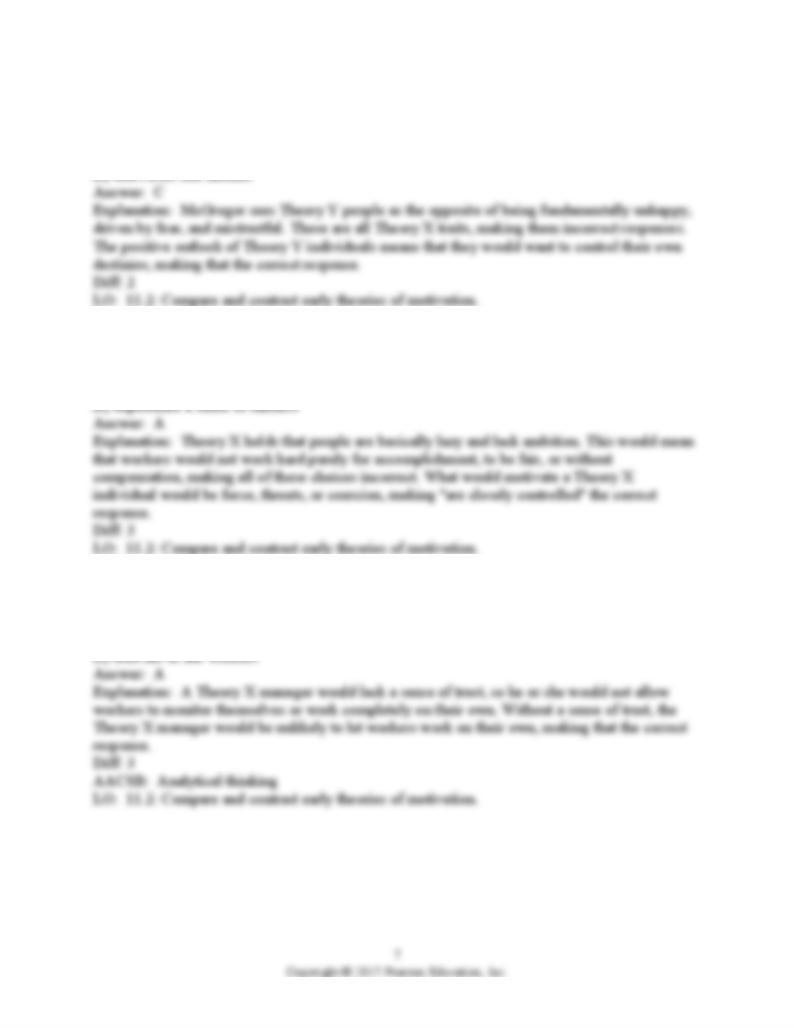
22) Theory Y assumes that people inherently ________.
A) are driven by fear
B) are unhappy
C) want to control their own destiny
23) Theory X assumes that people work hard when they ________.
A) are closely controlled
B) enjoy a sense of accomplishment
C) are not compensated
24) A manager with a Theory X view of human nature would ________.
A) be unlikely to allow workers to work independently
B) be likely to let workers coordinate their work
C) allow workers to monitor themselves
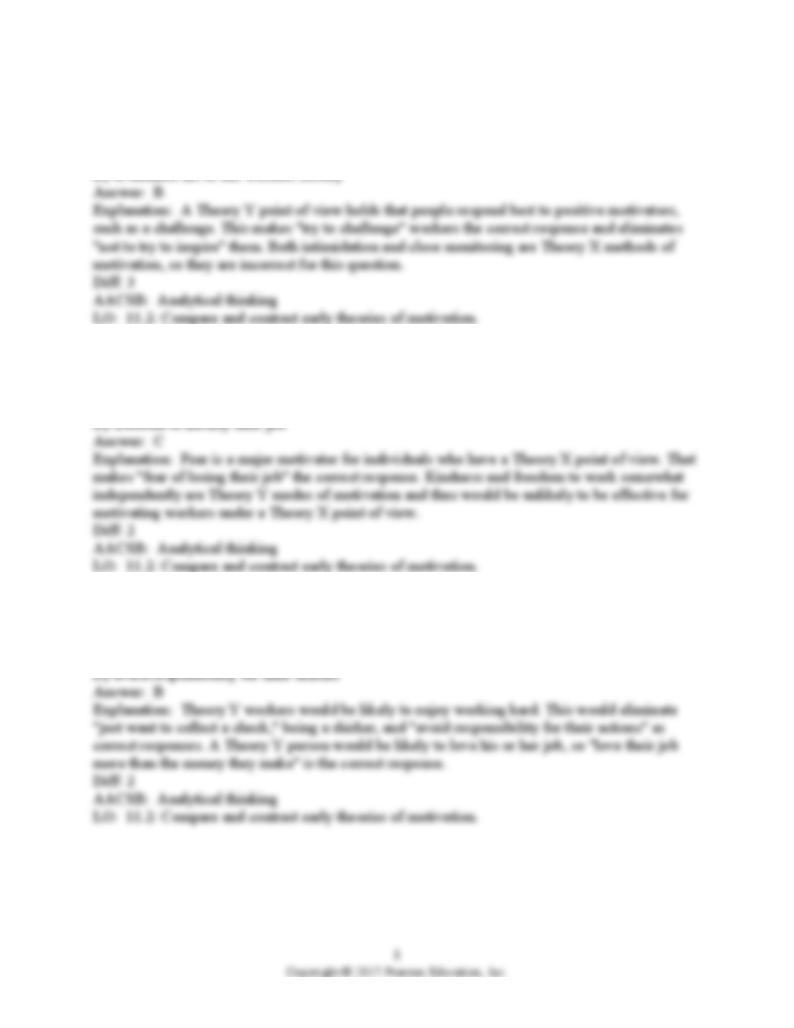
25) A manager with a Theory Y view of human nature would be likely ________.
A) not to try to inspire his or her workers
B) to try to challenge his or her workers
C) to try to intimidate his or her workers
26) Workers with a Theory X point of view would be most likely to respond to ________.
A) kindness
B) a hands-off approach
C) fear of losing their job
27) Workers with a Theory Y point of view would be likely to ________.
A) just want to collect a paycheck
B) love their job more than the money they make
C) avoid work unless rewards were high
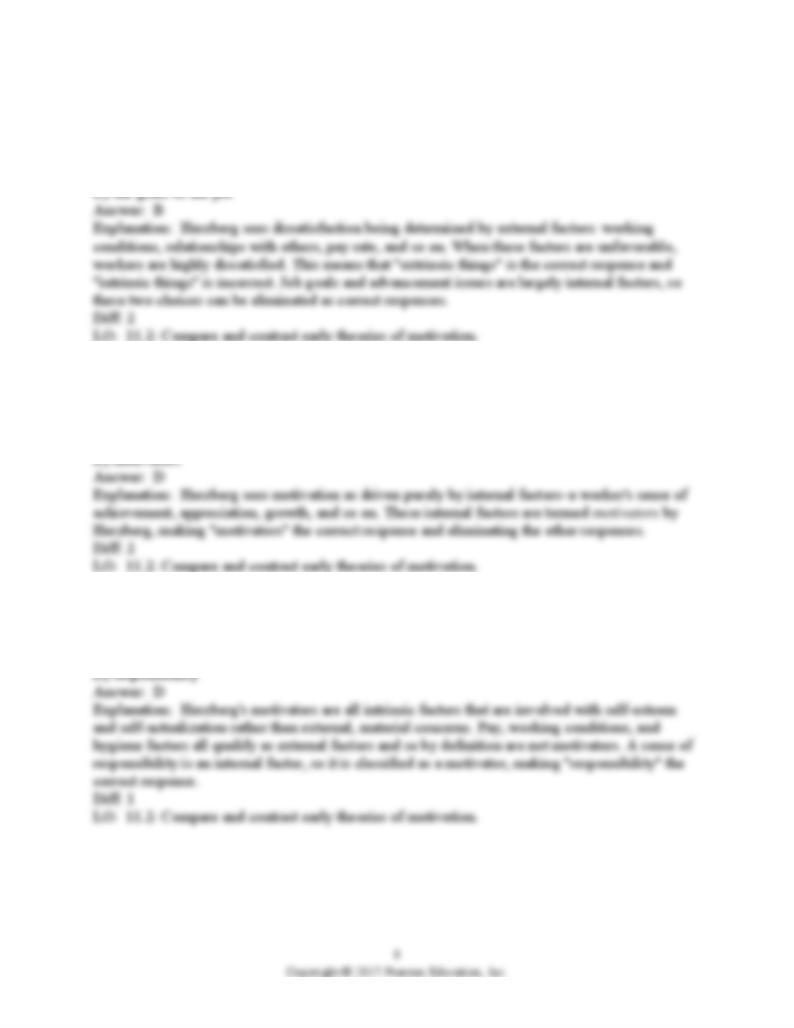
28) According to Herzberg, which kinds of characteristics are most closely associated with job
dissatisfaction?
A) intrinsic things that come from within themselves
B) extrinsic things that come from the outside
C) lack of advancement
29) According to Herzberg's Motivation-Hygiene theory, ________ are associated with job
satisfaction.
A) rewards
B) punishments
C) hygiene factors
30) According to Herzberg, which of the following is considered a motivator?
A) pay
B) working conditions
C) hygiene factors
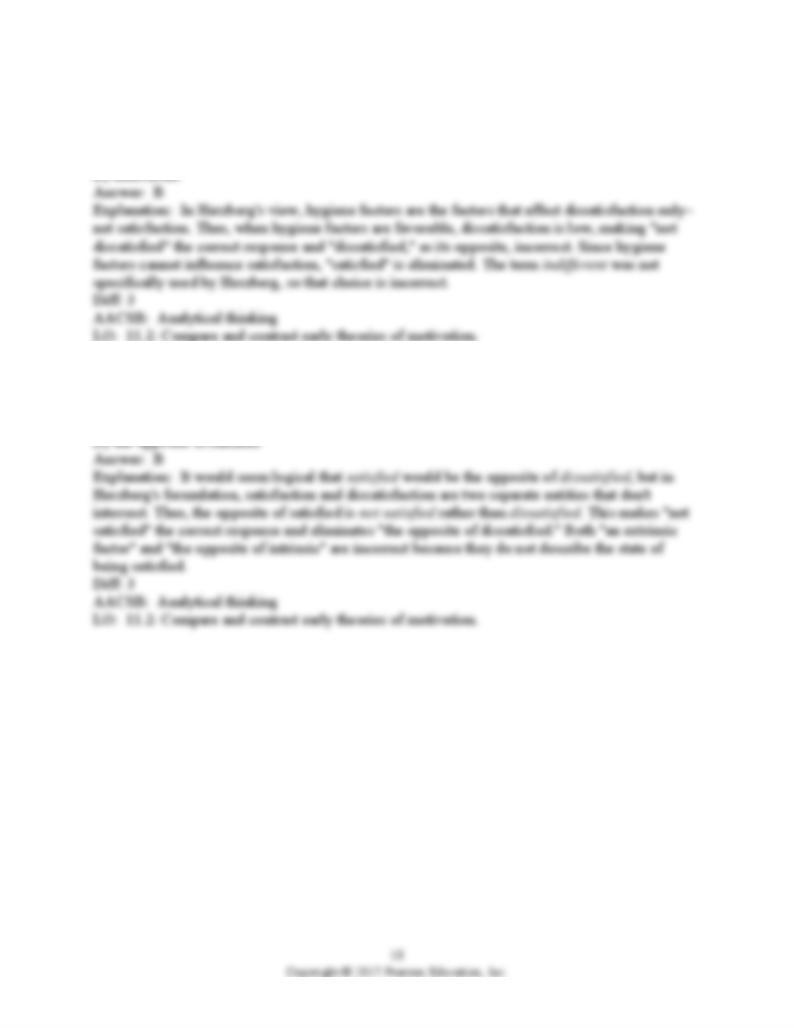
31) According to Herzberg, favorable hygiene factors can cause an employee to feel ________.
A) satisfied
B) not dissatisfied
C) dissatisfied
32) According to Herzberg, the opposite of the state of being satisfied is ________.
A) the opposite of dissatisfied
B) not satisfied
C) an extrinsic factor
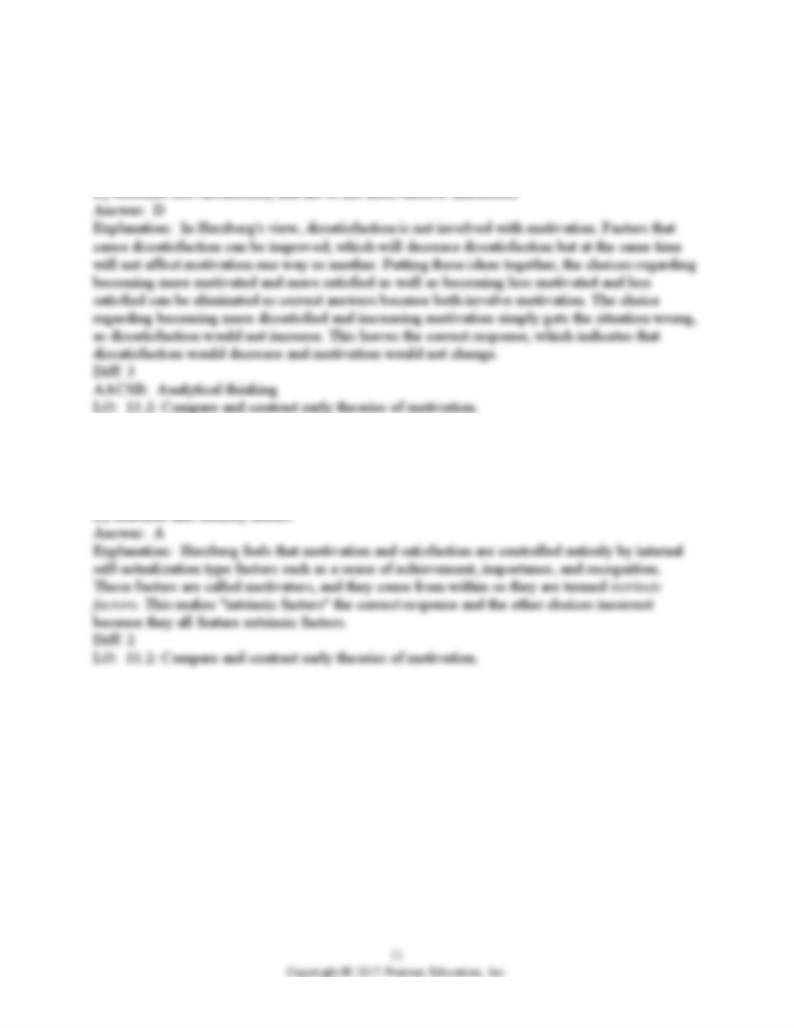
33) According to Herzberg, when an extremely dissatisfied employee gets an improved salary
and working conditions, he or she ________.
A) becomes more motivated and more satisfied
B) becomes less motivated and less satisfied
C) becomes more dissatisfied, and his or her motivation increases
34) According to Herzberg, what controls satisfaction and motivation?
A) intrinsic factors
B) extrinsic factors
C) both intrinsic and extrinsic factors
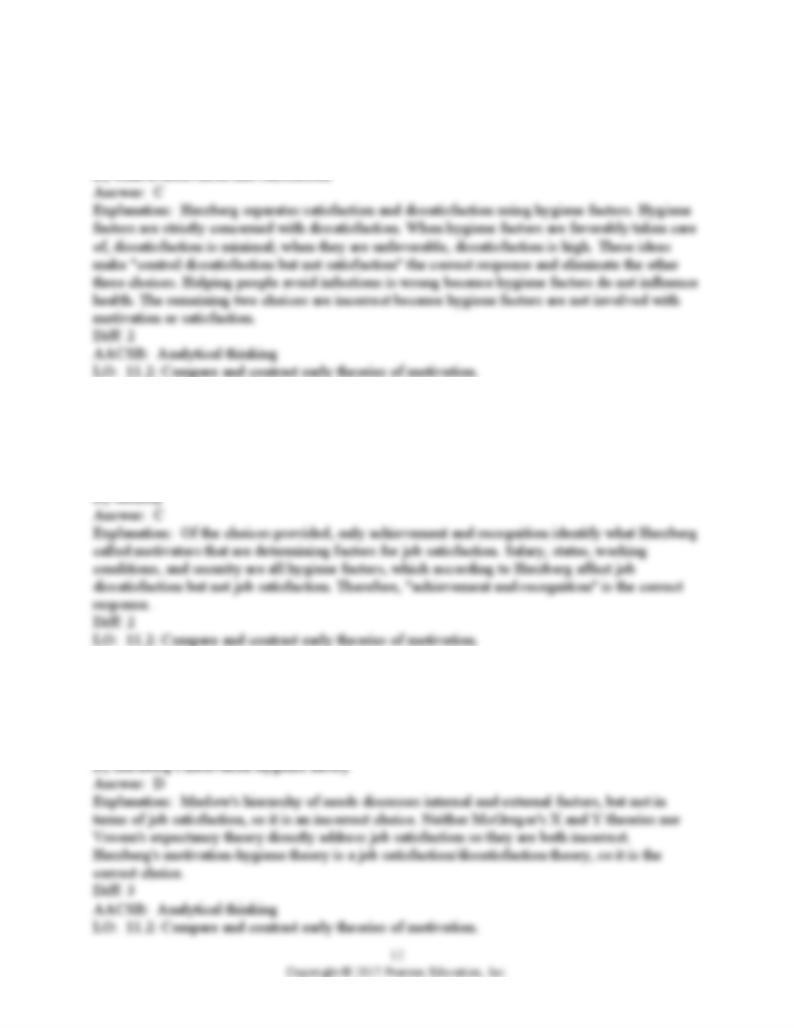
35) According to Herzberg, hygiene factors ________.
A) help people avoid infections
B) control motivation but not satisfaction
C) control dissatisfaction but not satisfaction
36) According to Herzberg, in order to provide employees with job satisfaction, managers should
concentrate on ________.
A) salary and status
B) working conditions
C) achievement and recognition
37) Which of the following holds that intrinsic factors are related to job satisfaction and extrinsic
factors are related to job dissatisfaction?
A) Maslow's hierarchy of needs
B) McGregor's Theory X and Theory Y
C) Vroom's expectancy theory
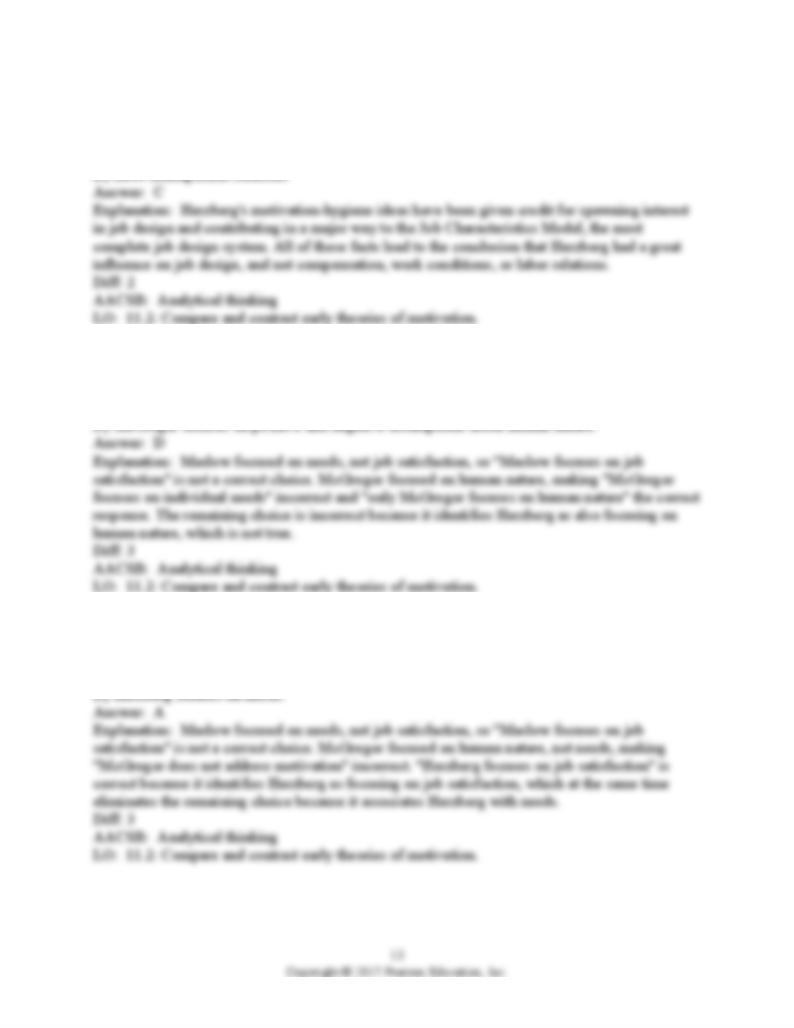
38) Herzberg has had the greatest influence on which of the following?
A) employee pay scales
B) work conditions
C) how managers design jobs
39) Which of the following is true of the three early theories of motivation?
A) Maslow focuses on job satisfaction.
B) McGregor focuses on the basic needs of the individual.
C) Both McGregor and Herzberg focus on human nature.
40) Which of the following is true of the three early theories of motivation?
A) Herzberg focuses on job satisfaction.
B) McGregor does not address motivation.
C) Maslow focuses on job satisfaction.
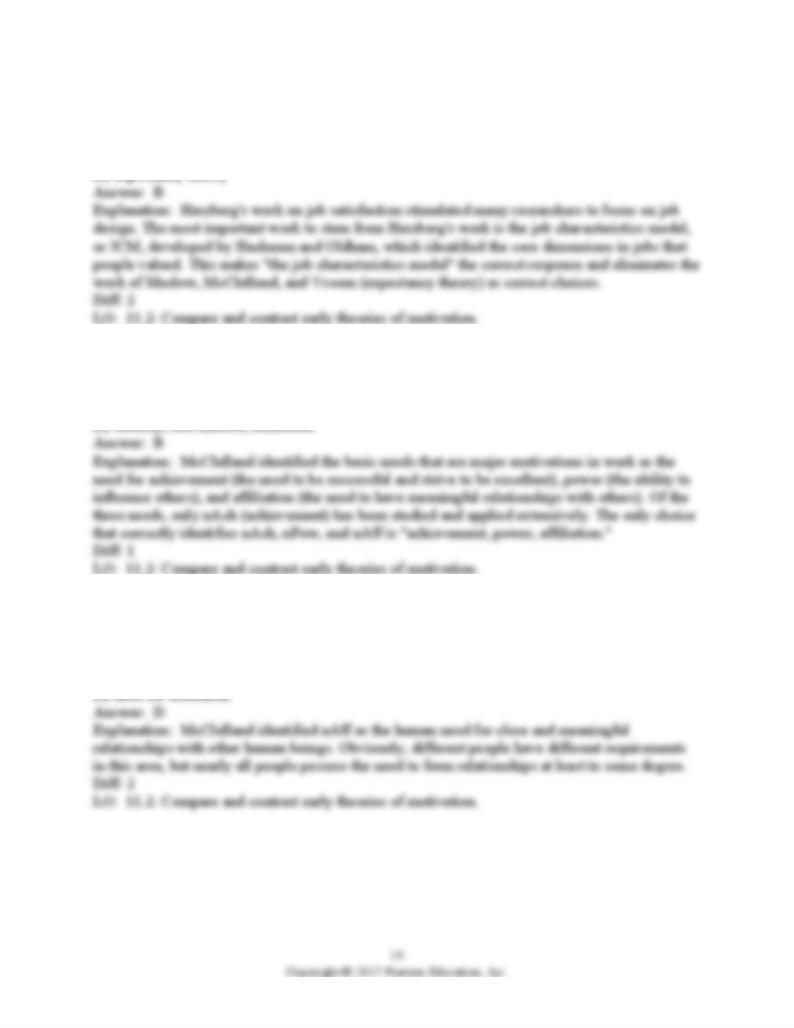
41) Which of the following was directly influenced by Herzberg's two-factor theory?
A) Maslow's hierarchy of needs
B) the job characteristics model
C) McClelland's three-needs theory
42) Which three needs are recognized in McClelland's three-needs theory?
A) achievement, power, security
B) achievement, power, affiliation
C) power, comfort, stimulation
43) Which of the following suggests that humans have an innate desire for friendly and close
interpersonal relationships?
A) need for achievement
B) need for power
C) need for fulfillment
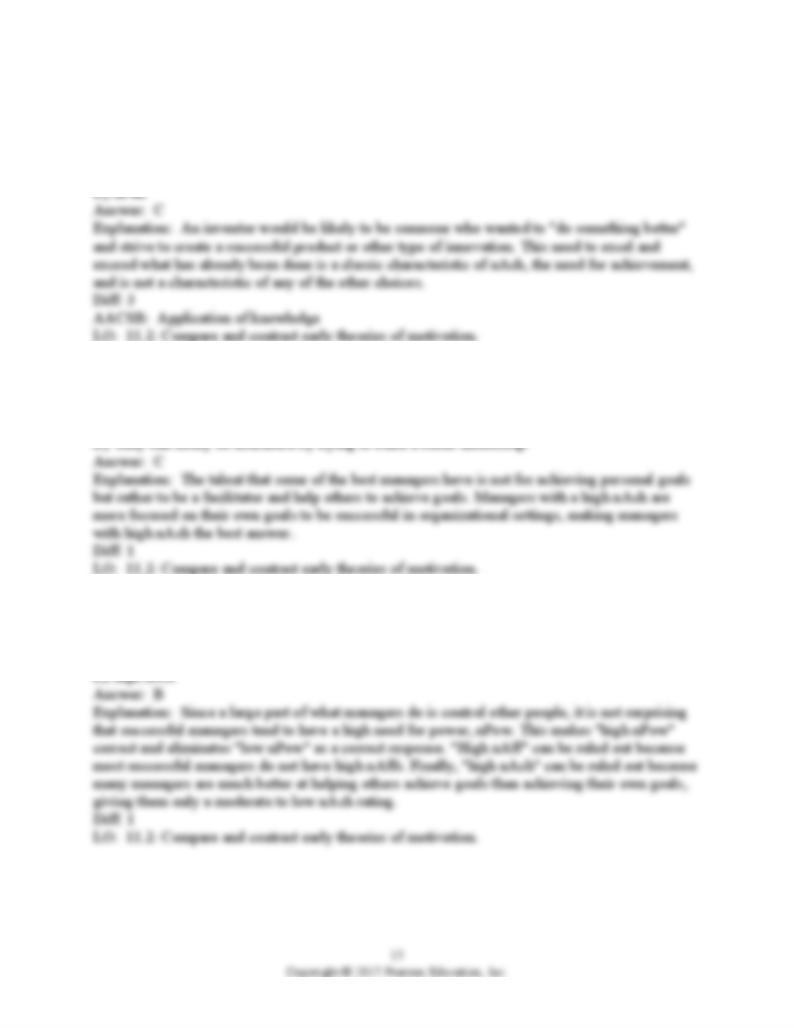
44) You would expect a successful inventor of a new type of heart valve to have a high
________.
A) nAff
B) nPow
C) nAch
45) Why are individuals with a high nAch not the most successful managers?
A) They are concerned more about effectiveness than efficiency.
B) They are more focused on organizational goals than their own desires for promotion.
C) They focus too much on their own goals than the goals of others.
46) Successful managers tend to have this more than any other trait.
A) low nPow
B) high nPow
C) high nAch

47) Successful managers tend to be better at ________.
A) doing their own work than helping others
B) identifying their own goals than identifying goals of subordinates
C) helping others achieve goals than achieving their own goals
48) McClelland's need that has received the most attention and research is the ________.
A) need for achievement
B) need for power
C) need for recognition
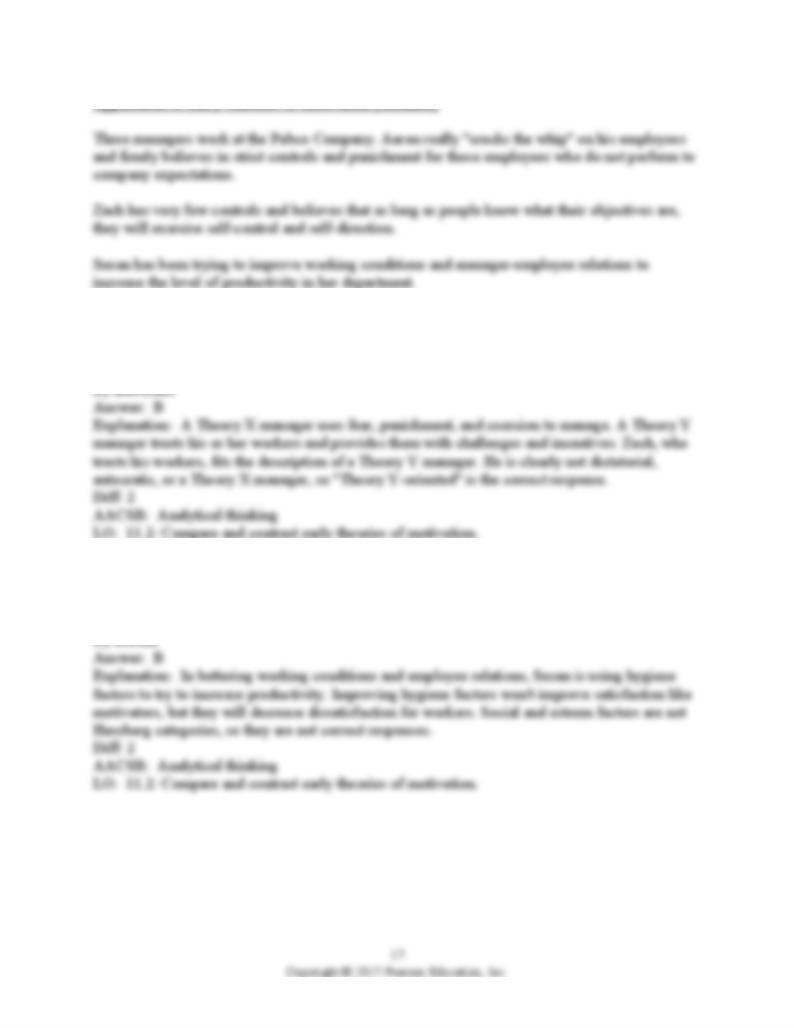
Application of Early Theories of Motivation (Scenario)
49) Zach is what type of manager?
A) Theory X-oriented
B) Theory Y-oriented
C) dictatorial
50) Susan was trying to use what type of Herzberg factors to increase productivity?
A) motivators
B) hygiene
C) social

51) Zach was using which type of Herzberg factors to increase productivity levels?
A) motivators
B) hygiene
C) social
52) Maslow's hierarchy of needs proposes that all needs are sought after to an equal degree at all
53) Maslow argued that each level in the needs hierarchy must be substantially satisfied before
54) Maslow contends that lower-order needs are satisfied internally and higher-order needs are
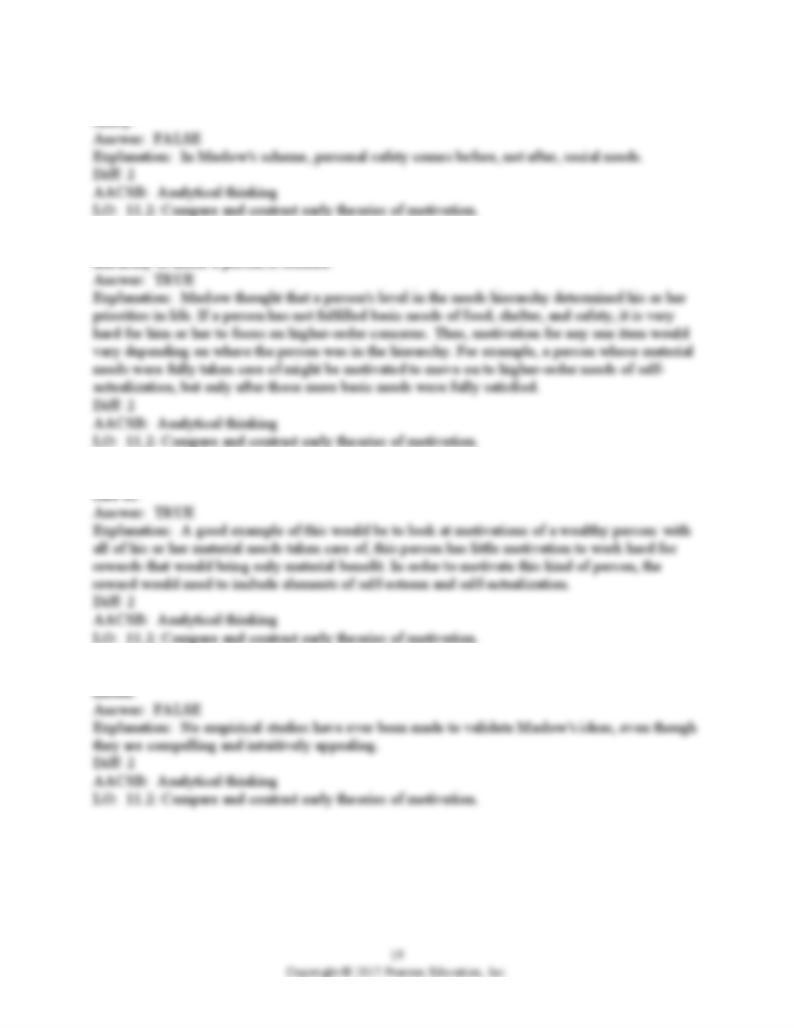
55) In Maslow's system, a person takes care of social needs before worrying about personal
56) In Maslow's view, the key to understanding motivation is to understand where in the
57) Maslow states that people can no longer be motivated by a given need if it is largely taken
58) Maslow's empirical studies provided substantial proof of the validity of his hierarchical
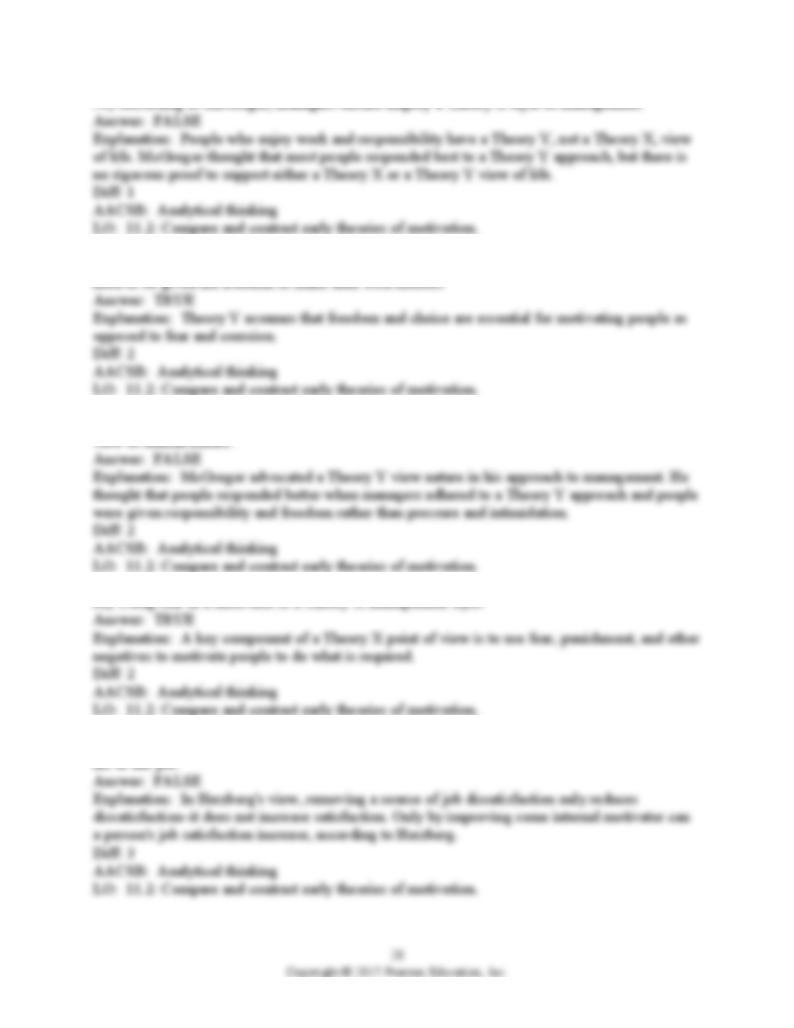
60) In McGregor's theory of motivation, managers with a Theory Y view of life think people
61) McGregor holds the opinion that managers are less successful when they adopt a Theory Y
63) In Herzberg's view, removing a factor of dissatisfaction makes a person more satisfied with
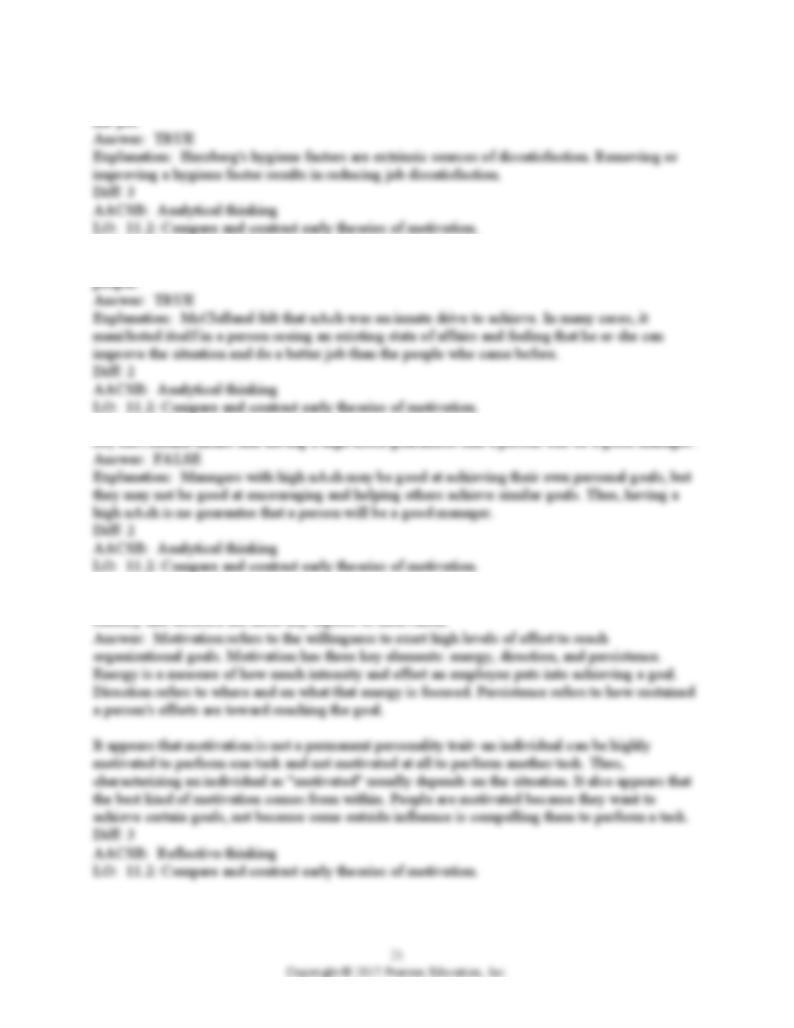
64) In Herzberg's view, removing a hygiene factor makes a person less dissatisfied with his or
65) McClelland proposed that people with a high nAch simply want to do things better than other
67) In a short essay, explain the concept of motivation with respect to an organization. Then

69) In a short essay, discuss why improving extrinsic hygiene factors does not, according to
70) Which is the best summary of goal-setting theory?
A) Goals make no difference in performance.
B) Specific goals increase performance.
C) Always make your goals very difficult to reach.
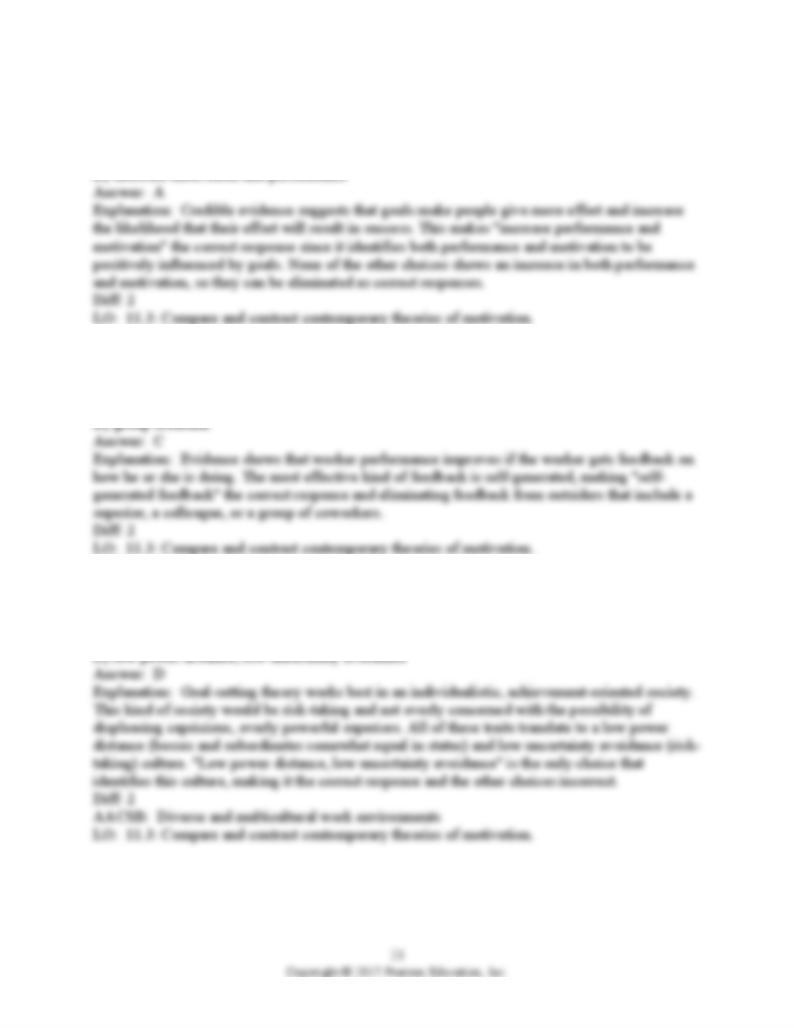
71) Setting goals definitely seems to ________.
A) increase performance and motivation
B) increase motivation but not performance
C) decrease performance but increase motivation
72) In goal-setting theory, which of the following is the best kind of feedback?
A) feedback from a superior
B) feedback from a peer
C) self-generated feedback
73) In which kinds of cultures does goal-setting theory work best?
A) high power distance, high uncertainty avoidance
B) low power distance, high uncertainty avoidance
C) high power distance, low uncertainty avoidance
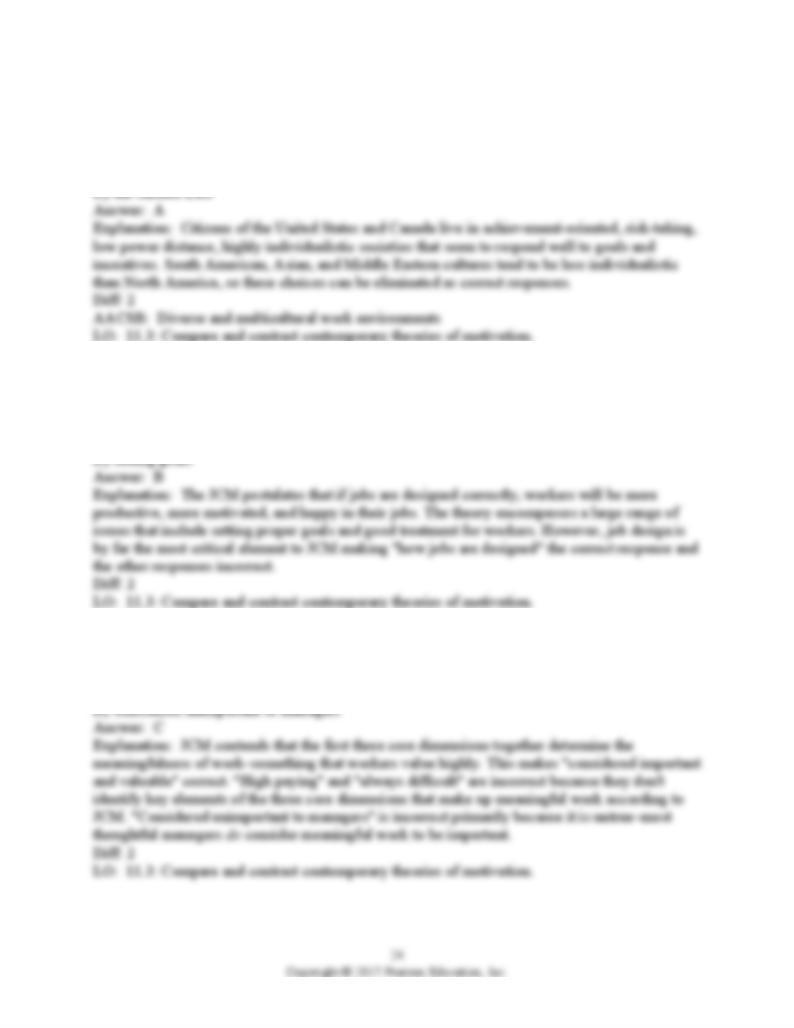
74) Goal-setting tends to do well in ________, where its basic ideas align well with general
cultural values.
A) North America
B) South America
C) India and China
75) The job characteristics model (JCM) maintains that ________ is critical to motivating
workers.
A) how workers are treated
B) how jobs are designed
C) equal treatment for all
76) The JCM contends that meaningful work is ________.
A) high paying
B) always difficult
C) considered important and valuable by the worker
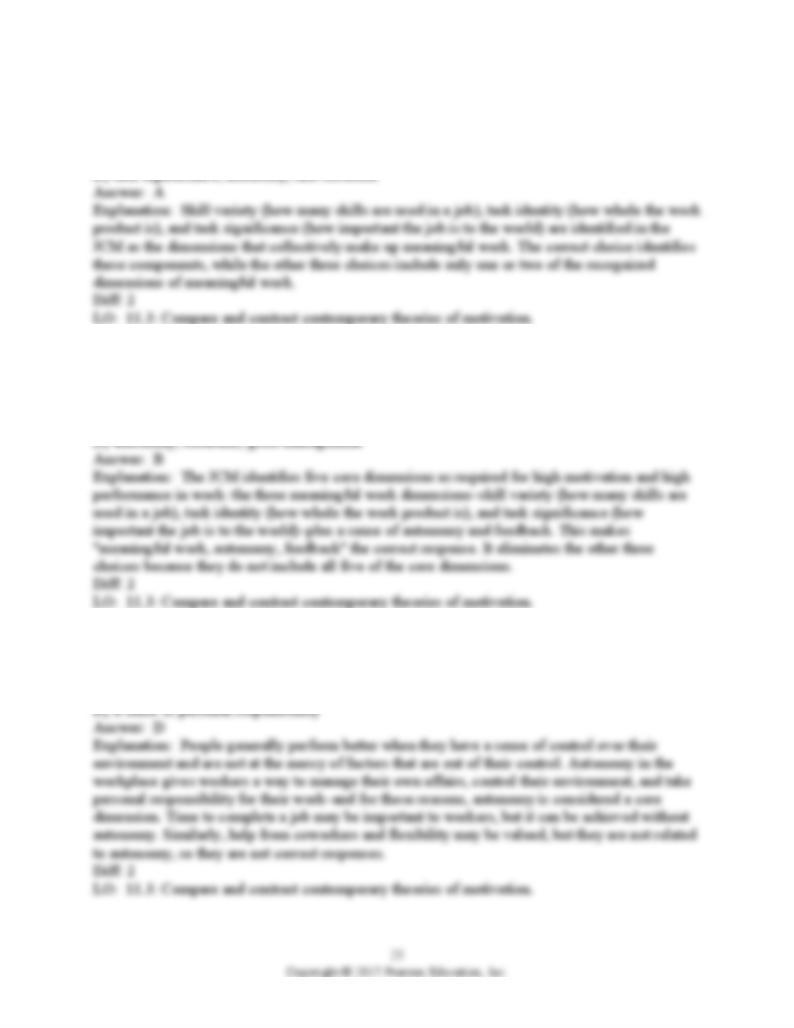
77) The JCM contends that ________ are required in meaningful work.
A) skill variety, task identity, and task significance
B) skill variety, autonomy, and feedback
C) task identity, autonomy, and feedback
78) The JCM contends that these dimensions are required for a high level of motivation among
workers.
A) high pay, autonomy, feedback
B) meaningful work, autonomy, feedback
C) meaningful work, autonomy, independence
79) Autonomy is important in the JCM because it gives the worker ________.
A) time to finish the job
B) help from fellow employees
C) flexibility in dealing with managers
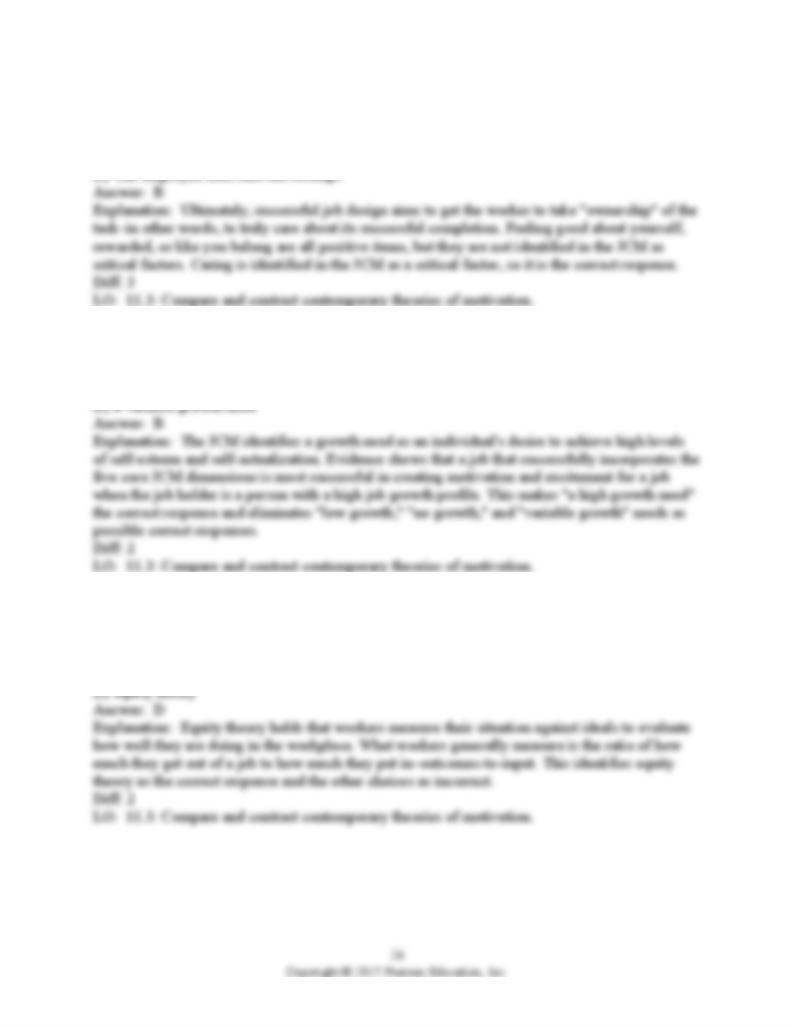
80) In the JCM, motivation and satisfaction increase when this is true.
A) The employee feels good about herself.
B) The employee cares about the task.
C) The employee feels rewarded.
81) Job enrichment in the JCM seems to work best with people who have ________.
A) a low growth need
B) a high growth need
C) no growth need
82) A theory that suggests that employees compare their inputs and outputs from a job to the
ratio of relevant others is known as ________.
A) action motivation
B) goal setting
C) reinforcement theory
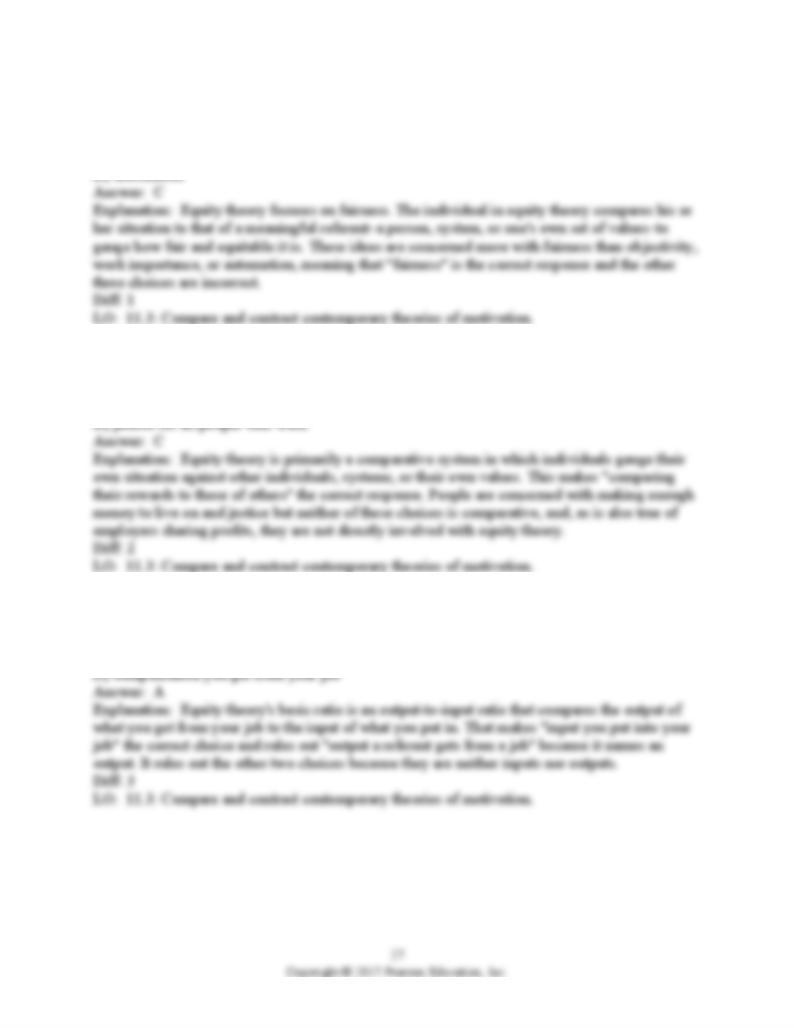
83) Equity theory is based primarily on ideas about which of the following?
A) objectivity
B) the importance of work
C) fairness
84) Equity theory recognizes that individuals are concerned with ________.
A) making enough money to live on
B) employers sharing profits
C) comparing their rewards to those of others
85) Equity theory uses the ratio of output you get from your job to the amount of ________.
A) input you put into your job
B) output a referent gets from a job
C) benefit you get from your job
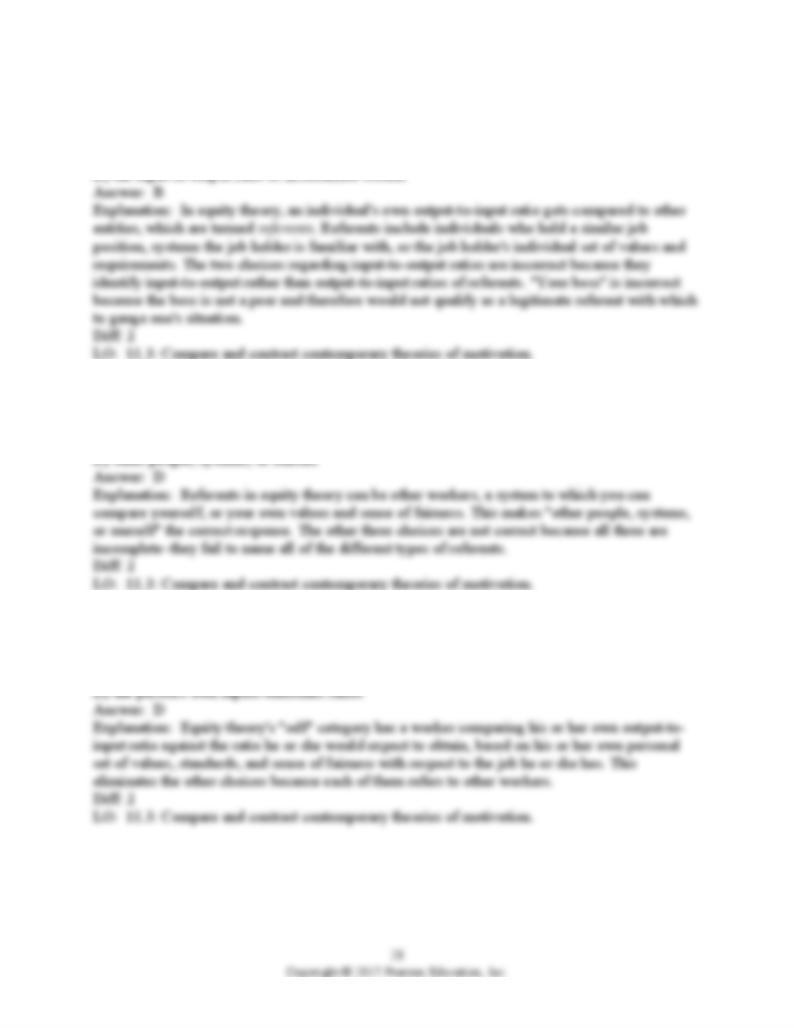
86) Equity theory compares your own outcomes-to-input ratio to that of ________.
A) your boss
B) a referent
C) the input-to-output ratio of another worker
87) A referent in equity theory refers to which of the following?
A) a theoretical worker
B) other people and systems only
C) oneself only
88) In equity theory, a worker's "self" category refers to ________.
A) the standards and expectations of other workers
B) their comparisons to the highest paid worker they know
C) their comparisons to the lowest paid worker they know
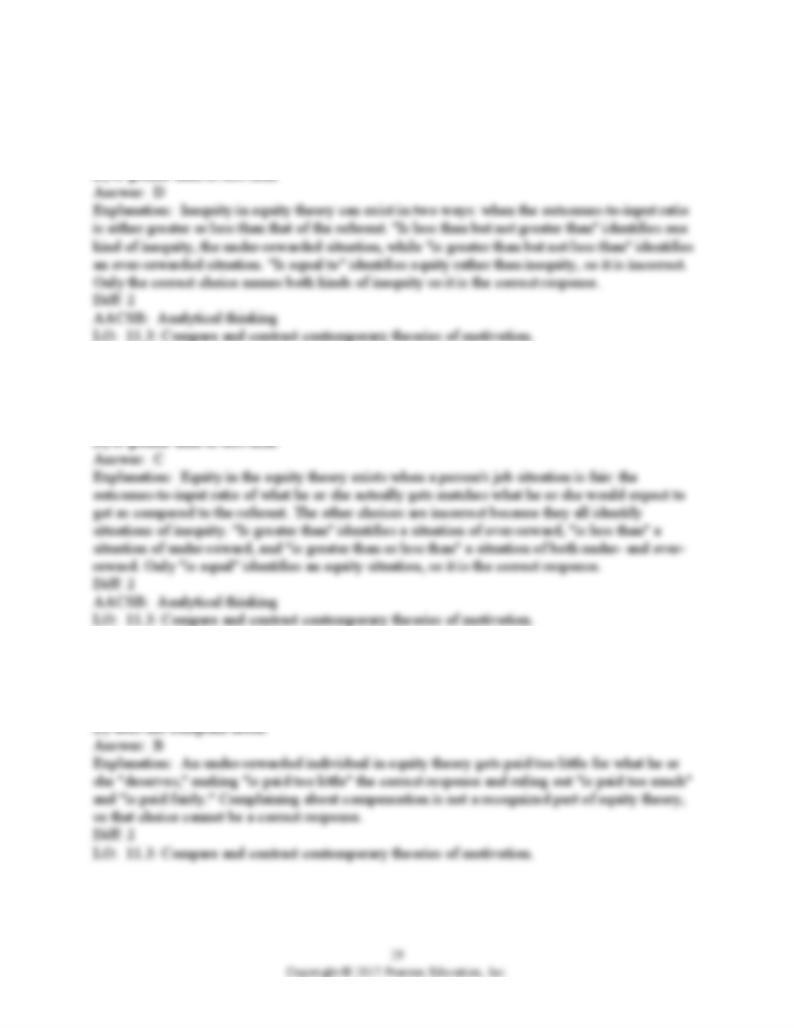
89) Inequity exists when one's own outcomes-to-input ratio ________ that of the referent.
A) is greater than but not less than
B) is less than but not greater than
C) is equal to
90) Equity exists when one's own outcomes-to-input ratio ________ that of the referent.
A) is greater than
B) is less than
C) is equal to
91) In equity theory, an under-rewarded individual ________ the work he or she does.
A) is paid too much for
B) is paid too little for
C) is paid fairly for
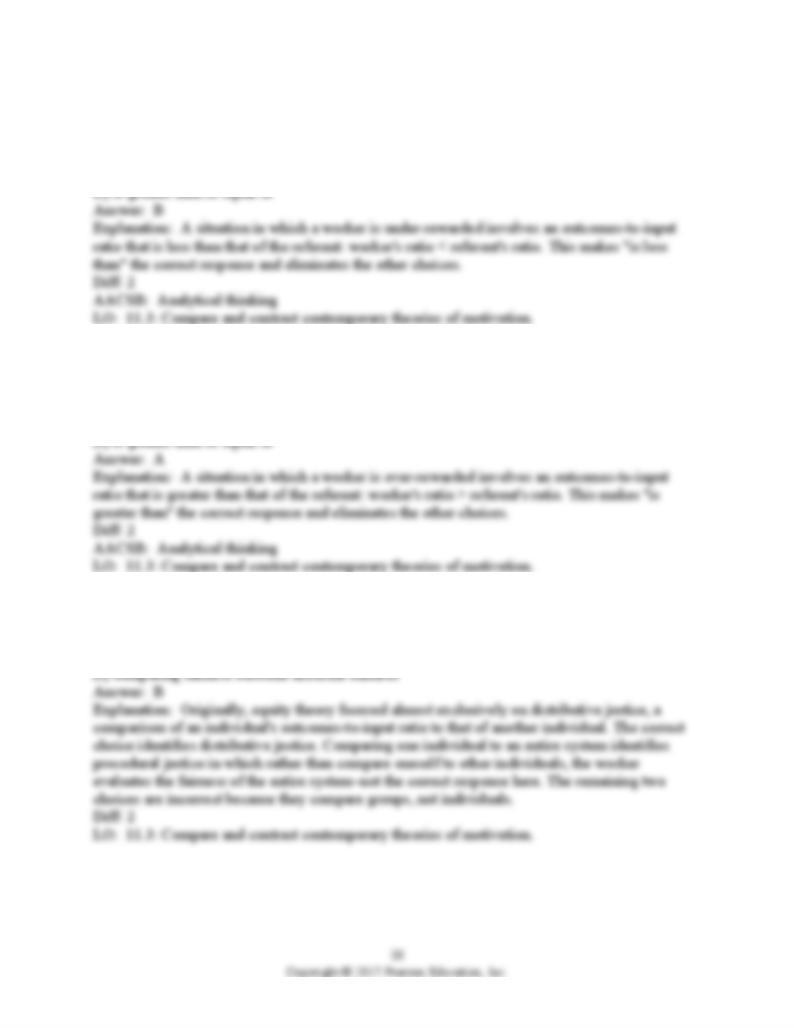
92) Under-rewarded inequity exists when one's own outcomes-to-input ratio ________ that of
the referent.
A) is greater than
B) is less than
C) is equal to
93) Over-rewarded inequity exists when one's own outcomes-to-input ratio ________ that of the
referent.
A) is greater than
B) is less than
C) is equal to
94) In equity theory, distributive justice is concerned with which of the following?
A) comparing one individual to an entire system
B) comparing output-to-input ratios among individuals
C) comparing output-to-input ratios among large groups
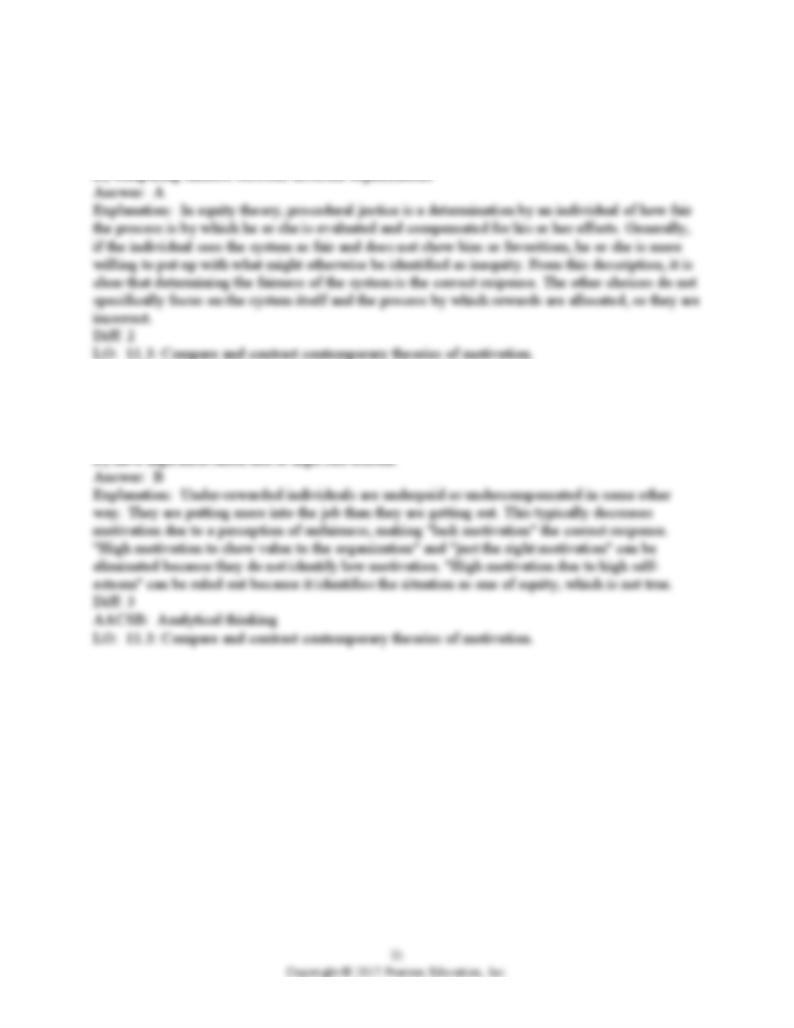
95) In equity theory, procedural justice is concerned with which of the following?
A) determining how fair the system is
B) determining how honest one's boss is
C) comparing output-to-input ratios among individuals
96) In equity theory, an under-rewarded individual is likely to ________.
A) have high motivation to show his or her value to the organization
B) lack motivation because he or she does not receive enough reward for what he or she does
C) have just the right motivation to get the job done
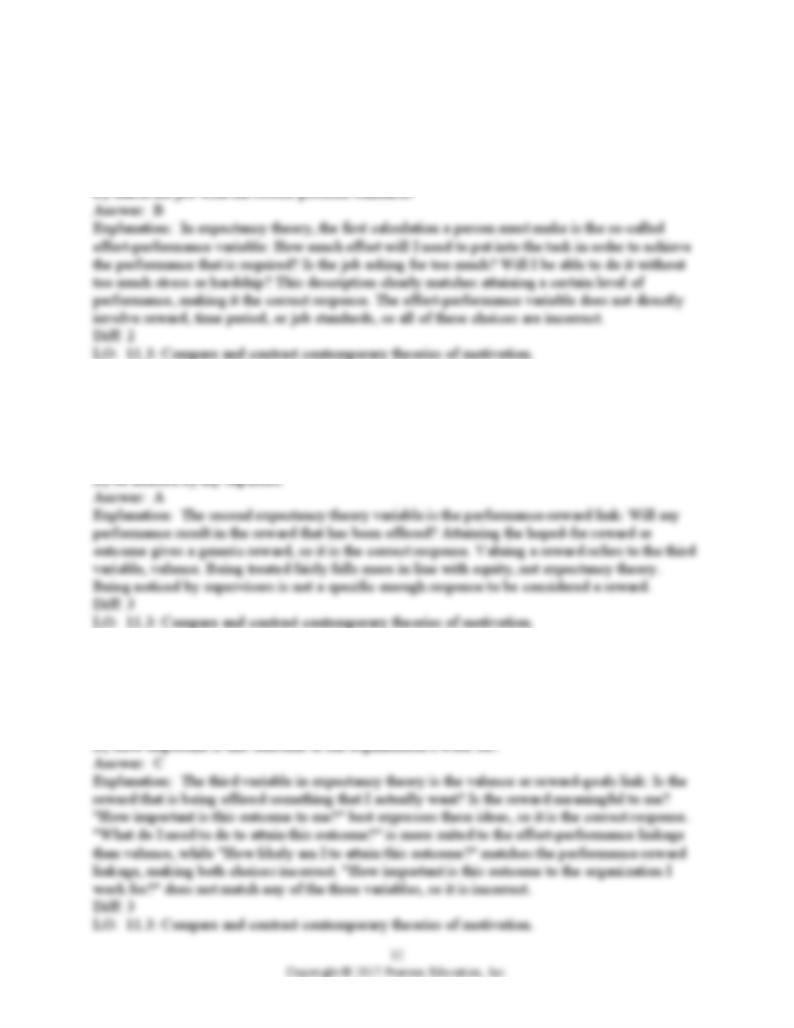
97) The first variable in expectancy theory involves how much effort a person must exert to
________.
A) receive a given reward
B) attain a certain level of performance
C) finish the job in the shortest period of time
98) The second variable in expectancy theory requires the worker to ask him- or herself: If I
perform at a given level, how likely is it that I will ________?
A) attain the reward or outcome I am looking for
B) value a promotion if I get it
C) be treated fairly
99) The third variable in expectancy theory requires the worker to ask him- or herself which
question?
A) How likely am I to attain this outcome?
B) What do I need to do to attain this outcome?
C) How important is this outcome to me?

100) In expectancy theory, a person may have the ability to reach a certain goal but lack
motivation because ________.
A) the goal is too easy
B) the goal is too hard
C) the person's desire to reach the goal is too strong
101) A key element of expectancy theory might be summarized by saying ________.
A) most people are motivated by money
B) everyone is always motivated by fear of failure
C) everyone is motivated by the same thing
102) The key to expectancy theory is that an individual's goals ________.
A) are not too high
B) are not too high and not too low
C) match the goals of fellow workers and superiors
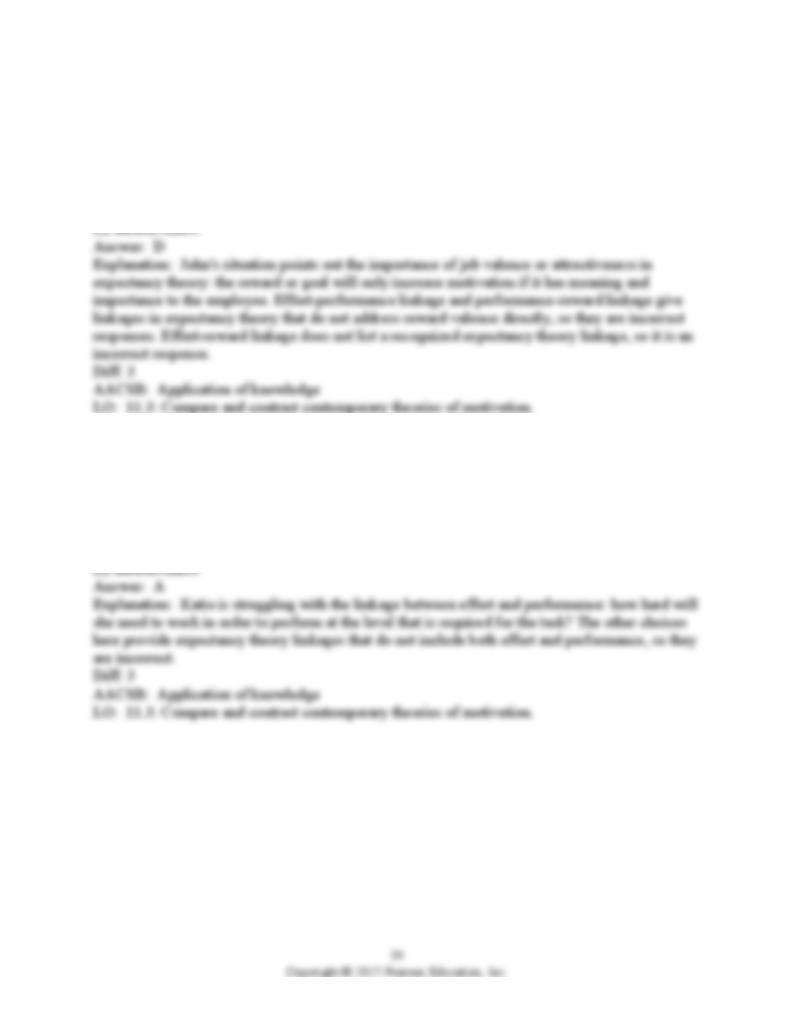
103) If salespeople in John's company meet their sales goals for the month, they are given an all-
expense-paid trip to a Denver Broncos football game. Football is not one of John's favorite
sports, and the Denver Broncos are definitely not John's favorite team. John's performance might
be influenced by the ________ part of Vroom's expectancy theory.
A) effort-performance linkage
B) performance-reward linkage
C) effort-reward linkage
104) Katie has just been asked to type up a report in two days using a software program she has
never seen before. Katie wonders if she will be able to get her project accomplished on time and
in the format wanted by her manager. This is an example of which variable in Vroom's
expectancy theory?
A) effort-performance linkage
B) performance-reward linkage
C) valence-reward linkage
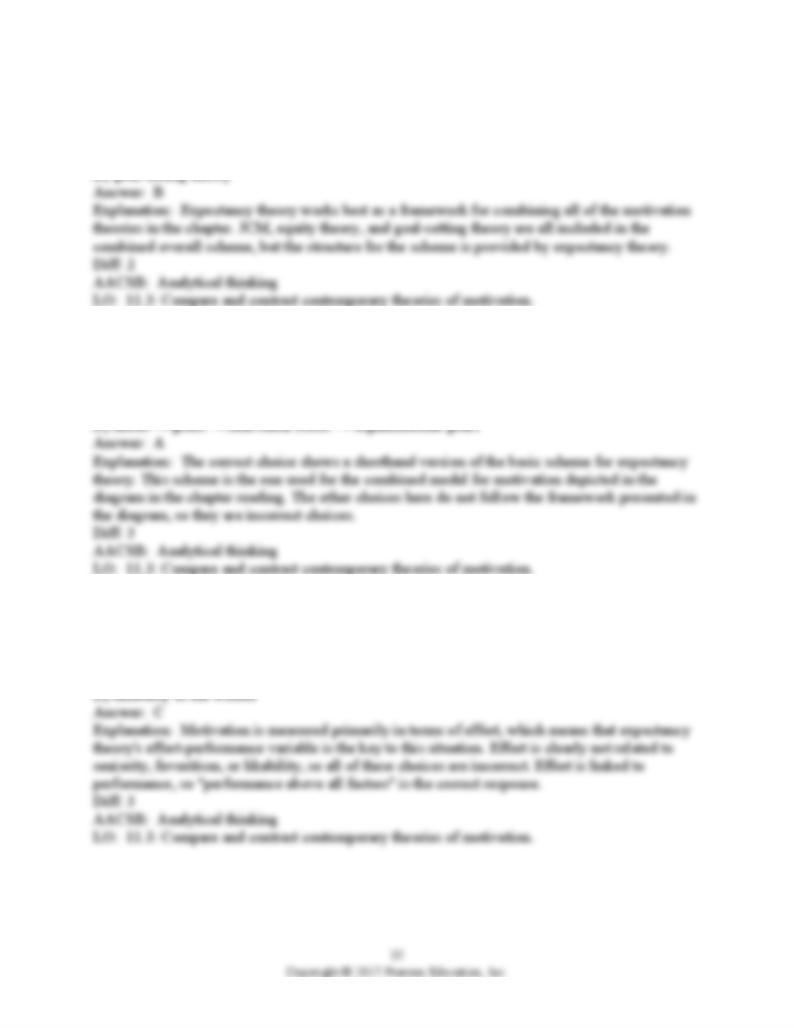
105) Which of the following theories of motivation is seen as the most comprehensive?
A) JCM theory
B) expectancy theory
C) equity theory
106) The integrated model for motivation as shown in the chapter reading features the following
basic sequence.
A) effort → performance → rewards → individual goals
B) effort → equity → goals → needs
C) needs → factors → extrinsic factors → individual goals
107) The integrated model for motivation as shown in the chapter reading predicts strong
motivation for an individual to perform when the reward is based on ________.
A) seniority or years of service in the organization
B) personal favorites of top managers
C) performance above all factors
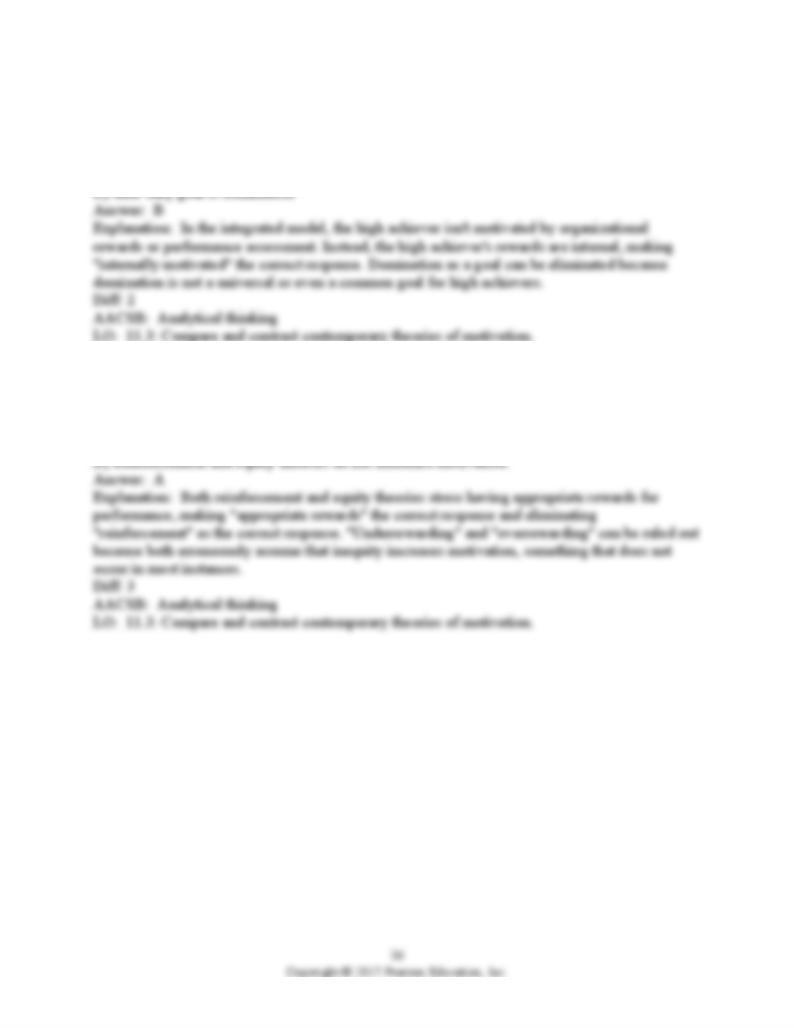
108) In the integrated model for motivation as shown in the chapter reading, high achievers
circumvent the entire sequence of steps for motivation because ________.
A) they are motivated by the organization's assessment of their performance
B) they are internally motivated, not motivated by rewards
C) they are motivated by rewards only, not by internal factors
109) In the integrated model for motivation as shown in the chapter reading, how do
reinforcement theory and equity theory figure in?
A) Appropriate rewards reinforce a high level of performance.
B) Underrewarding results in "hungry" employees who will work harder.
C) Overrewarding results in "satisfied" employees who will work harder.
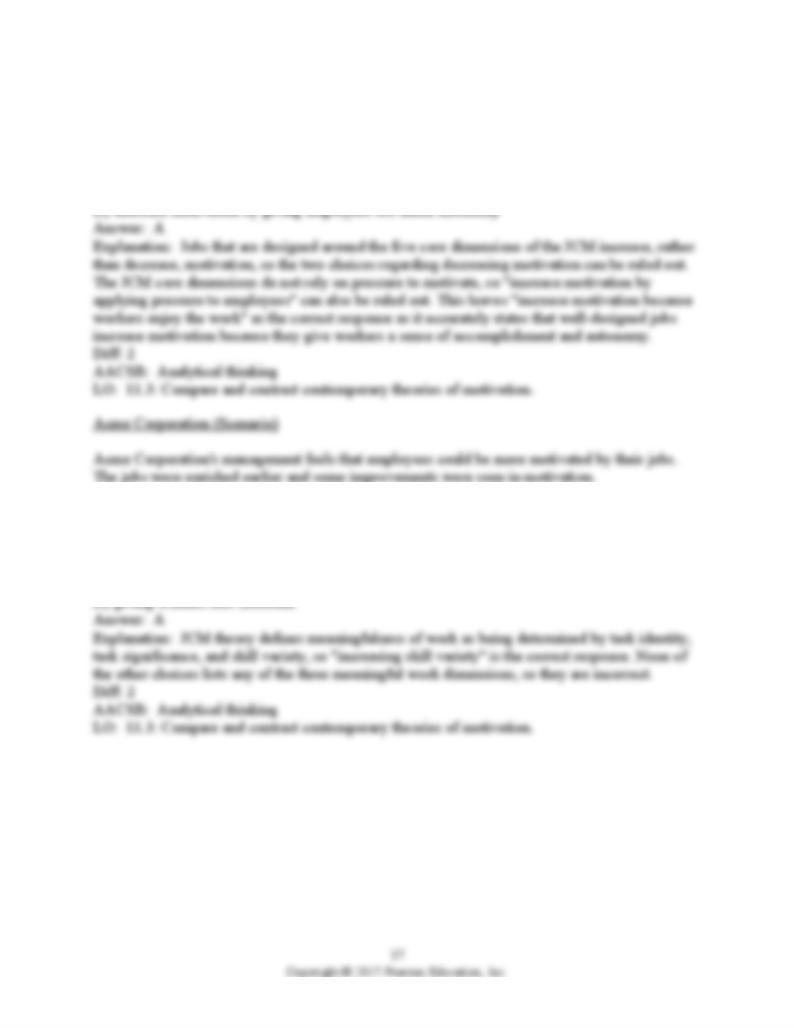
110) The JCM is seen in the integrated model of motivation in that jobs that are designed around
the five JCM dimensions ________.
A) increase motivation because workers enjoy the work and autonomy they provide
B) decrease motivation because the work is too easy to complete and the autonomy lacks
structure
C) increase motivation by applying pressure to employees
111) To increase the motivation through enrichment, Acme decides to increase the
meaningfulness of the work. This might be done by ________.
A) increasing skill variety
B) increasing autonomy of workers
C) giving workers more feedback
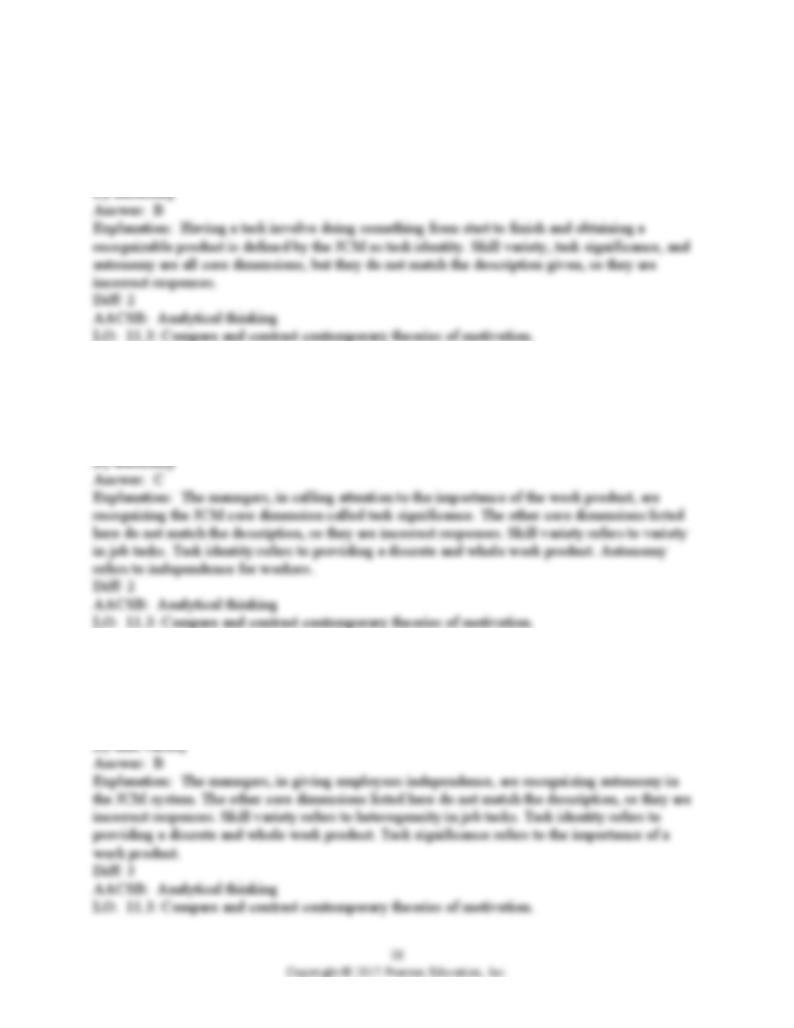
112) Most jobs at Acme were redesigned to allow the employees to complete a whole and
identifiable piece of work. This fits ________, a core dimension of the job characteristics model.
A) skill variety
B) task identity
C) task significance
113) Acme managers explained how important their product was to the world economy. Which
core dimension in the job characteristics model is this?
A) skill variety
B) task identity
C) task significance
114) The Acme managers developed a program that allows the employees to have a large degree
of freedom carrying out their jobs. Which core dimension are they providing?
A) task significance
B) autonomy
C) task identity
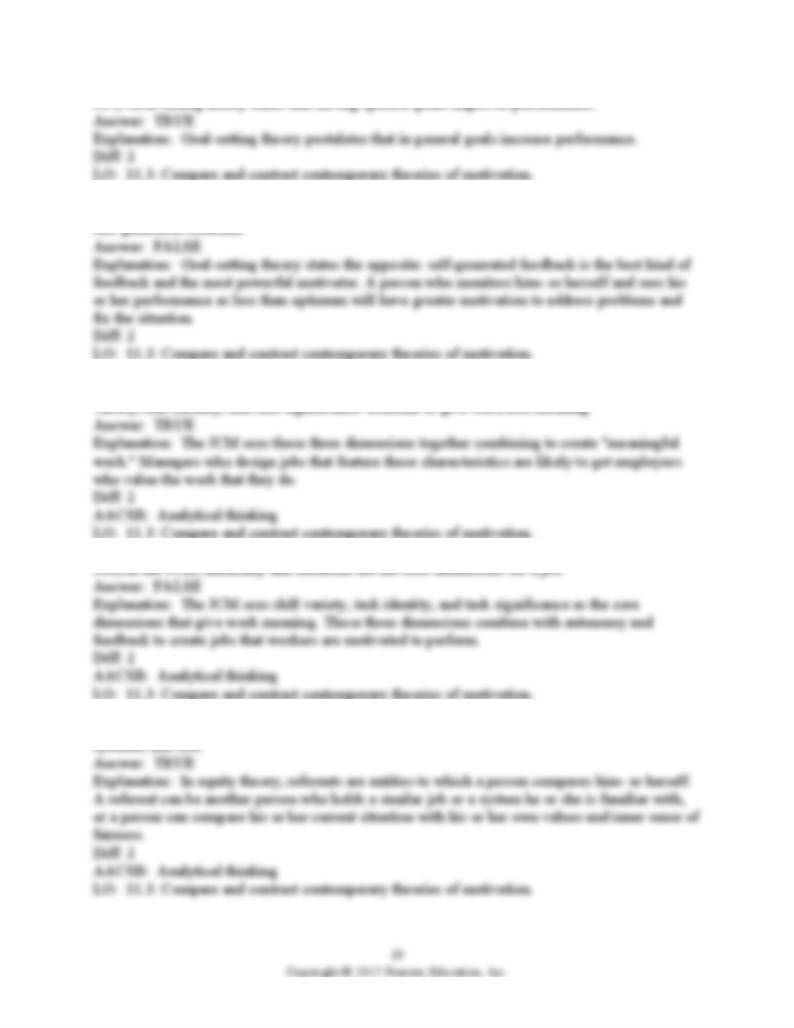
116) Goal-setting theory shows that feedback from a superior provides better motivation than
117) The job characteristics model, or JCM, holds that the three core job dimensions–skill
119) Equity theory has three referent categories to which workers compare themselves: persons,
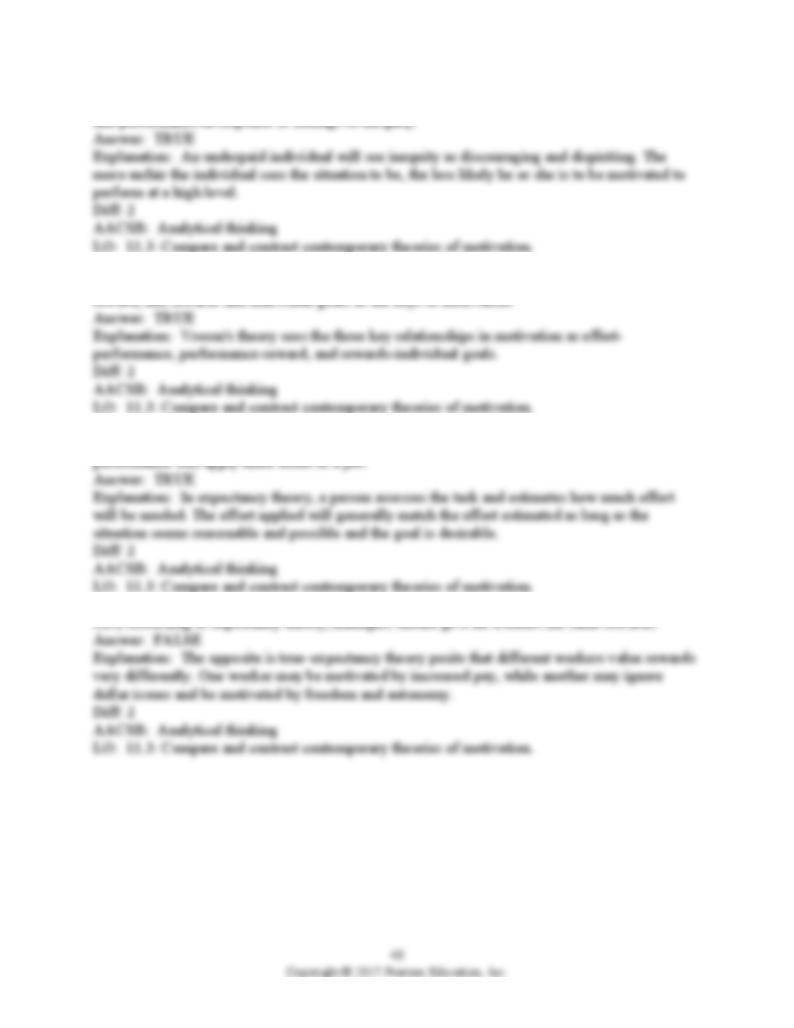
120) Equity theory holds that employees who feel underpaid will decrease their level of effort
121) Vroom's expectancy theory sees a link between effort and performance, performance and
122) Vroom's expectancy theory would say that a worker with a higher expectation of
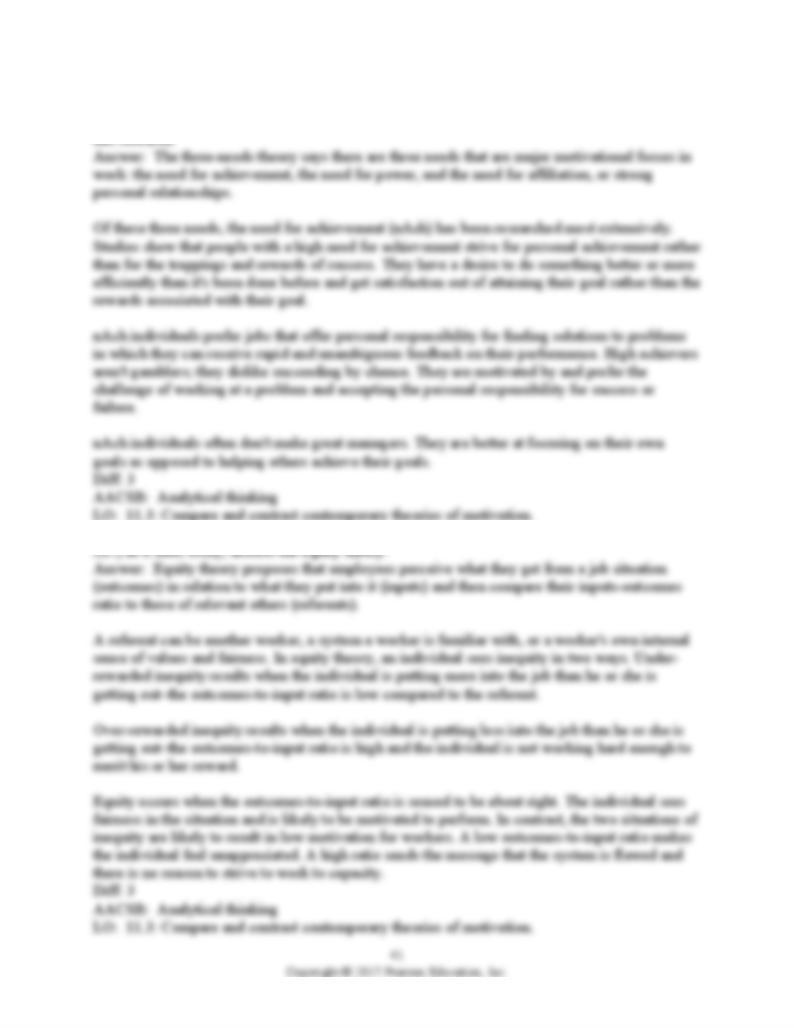
124) In a short essay, list and discuss the three-needs theory according to David McClelland.
Then identify which of these needs has been studied most extensively and discuss the findings of
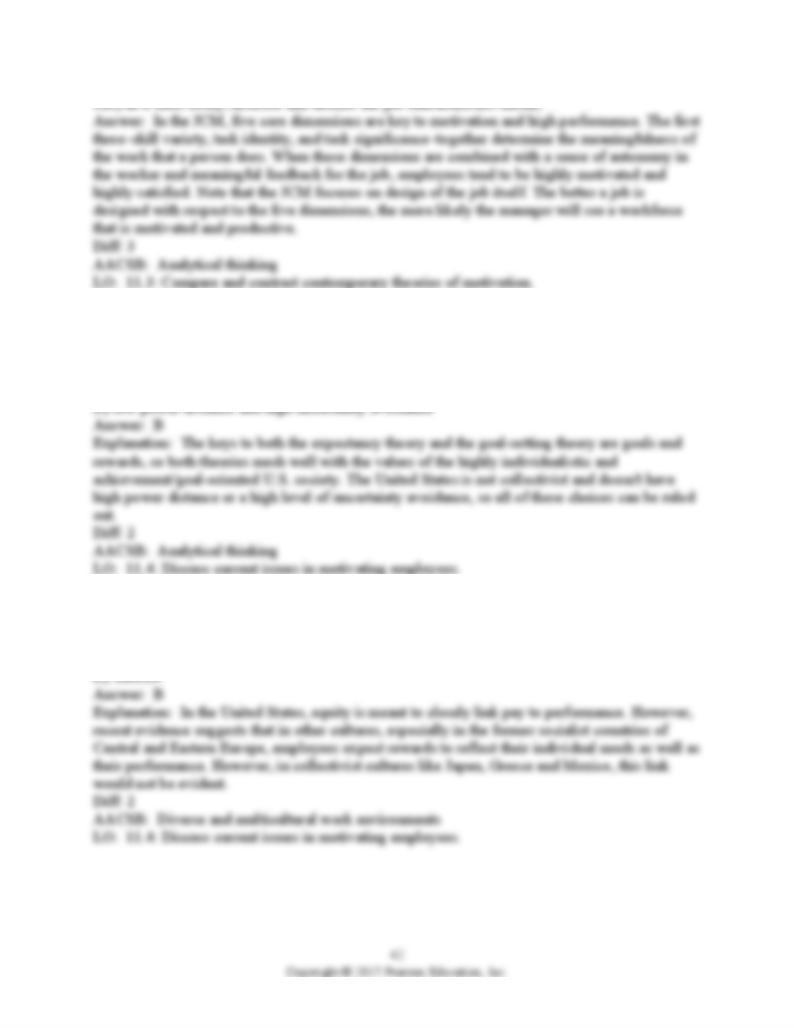
127) Expectancy theory and goal-setting theory align well with American workers because
American culture places a strong emphasis on ________.
A) collectivism and achievement
B) achievement and individualism
C) individualism and high power distance
128) In which country is equity meant to closely link pay to performance?
A) Japan
B) United States
C) Greece
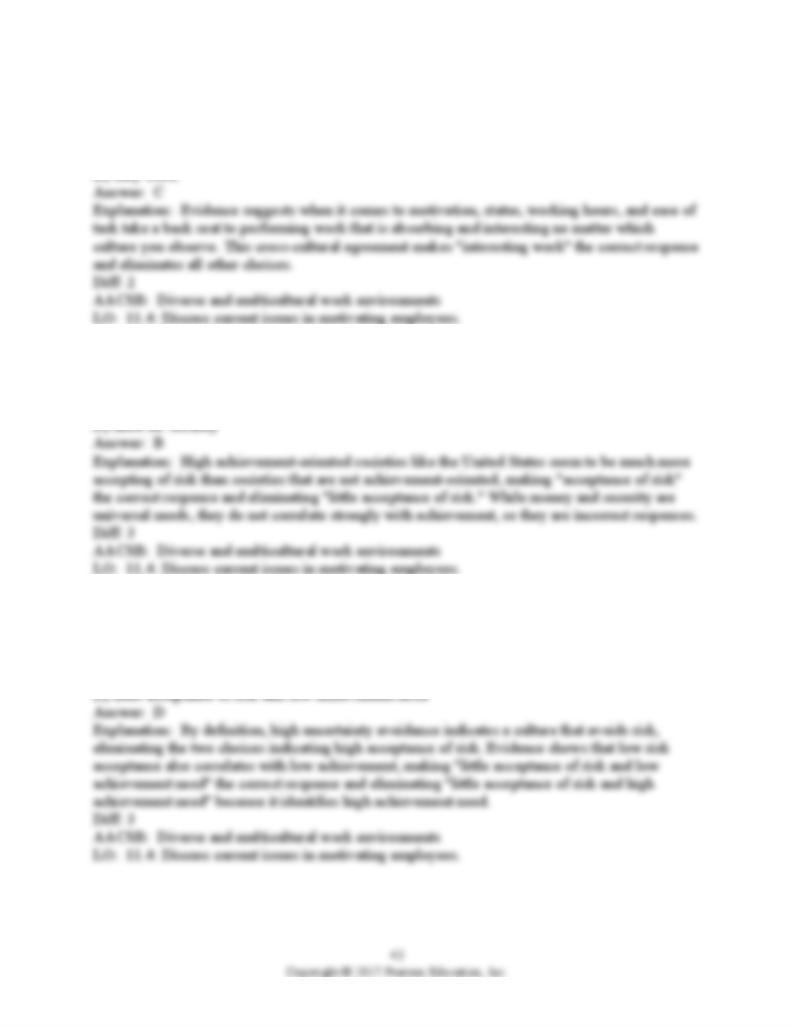
129) One factor that seems to motivate workers across all cultures is seeking ________.
A) high status
B) shorter working hours
C) interesting work
130) Across cultures, the need for achievement seems to correlate with which of the following?
A) need for money
B) acceptance of risk
C) little acceptance of risk
131) In countries with high levels of uncertainty avoidance, which of the following would you
expect?
A) little acceptance of risk and high achievement need
B) high acceptance of risk and high achievement need
C) high acceptance of risk and low achievement need
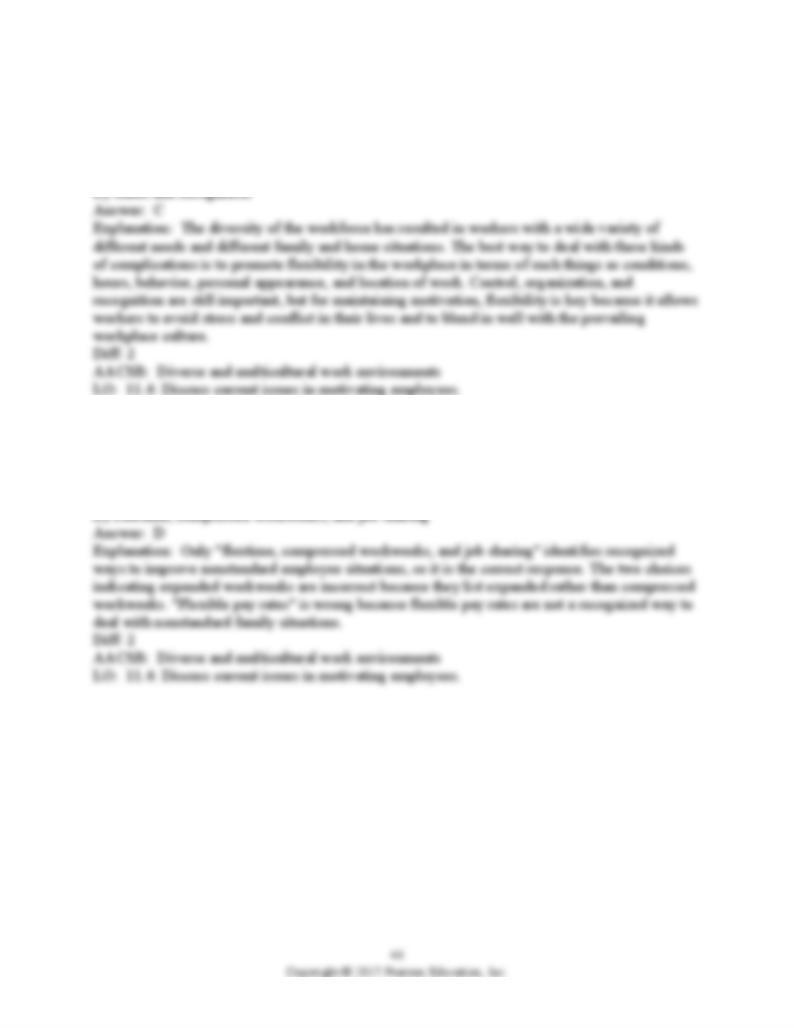
132) In today's diverse workforce, which factor do managers need to focus on most to maximize
motivation?
A) control
B) well-organized workplace
C) flexibility
133) ________ allow companies to accommodate the needs of workers with nonstandard family
situations.
A) Flextime and expanded workweeks
B) Expanded workweeks and job sharing
C) Flexible pay rates
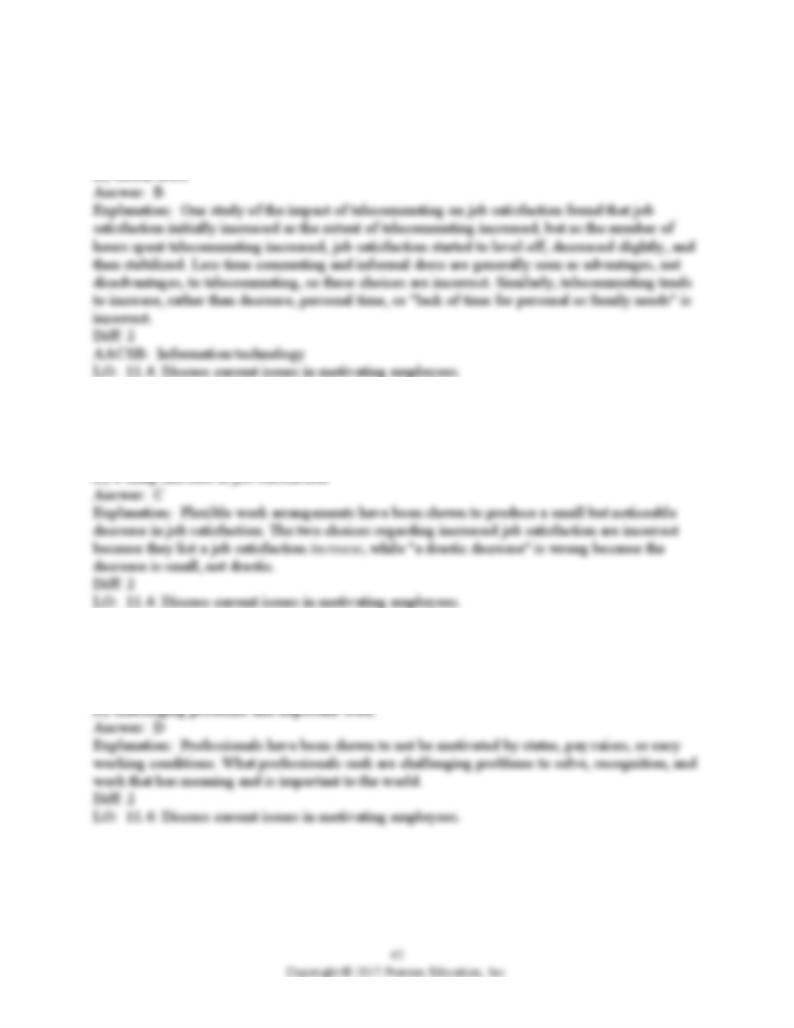
134) What is a potential disadvantage of telecommuting?
A) lack of time for personal or family needs
B) job satisfaction may decrease due to working hours
C) less time spent commuting
135) Which of the following describes the effect of flexible work arrangements on employees?
A) increased job satisfaction
B) a drastic decrease in job satisfaction
C) a small decrease in job satisfaction
136) Which of the following is thought to best motivate professionals?
A) high pay
B) status and power within the organization
C) short hours and good working conditions
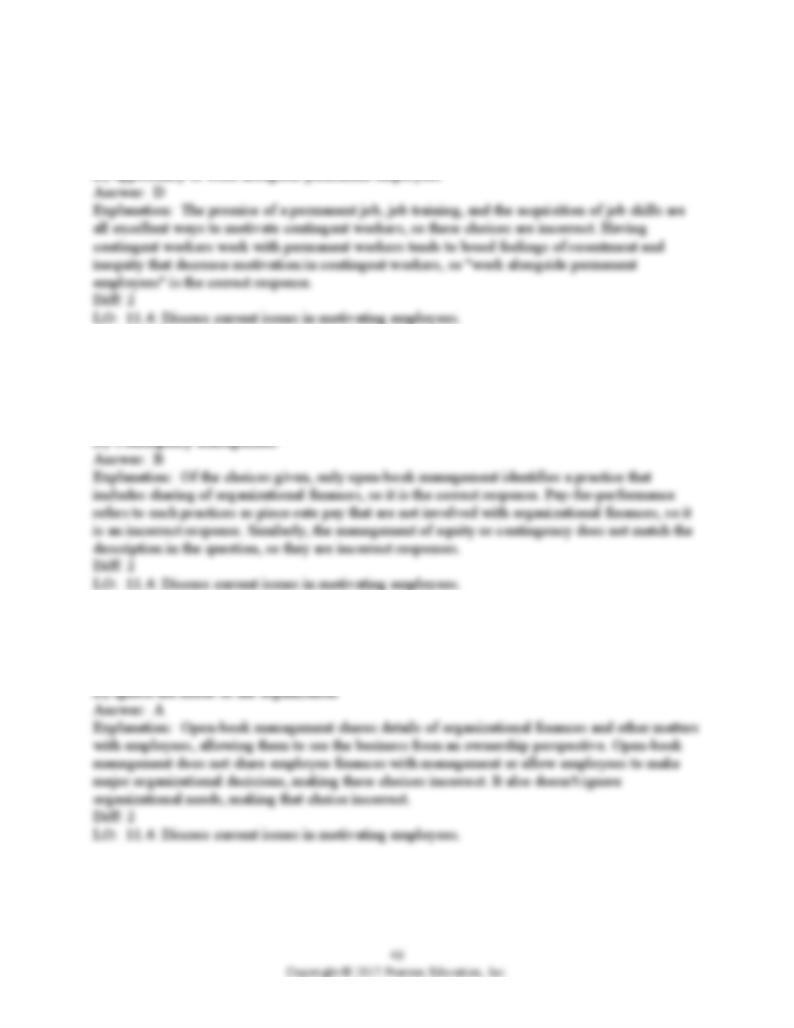
137) Which of the following is NOT recognized as a way to motivate contingent workers?
A) promise of permanent employment in the future
B) opportunity for training
C) opportunity to develop marketable skills
138) ________ can improve employee performance by sharing the financial circumstances of the
organization with the employee.
A) Pay-for-performance
B) Open-book management
C) Equity management
139) Open-book management encourages employees to ________.
A) think like an owner
B) share their financial situations with management
C) make all top-level decisions for the organization

140) What is a recognized way for a manager to motivate low-skilled, minimum-wage
employees?
A) music in the workplace
B) employee recognition programs
C) coercing low-performing employees
141) In employee recognition programs, employees accumulate points for things such as
________.
A) recruiting new workers
B) whistle-blowing on corruption
C) increased productivity
142) Which of the following is NOT a common way that employee recognition programs
recognize worker achievements?
A) added worker responsibilities
B) a party
C) a handwritten note of thanks
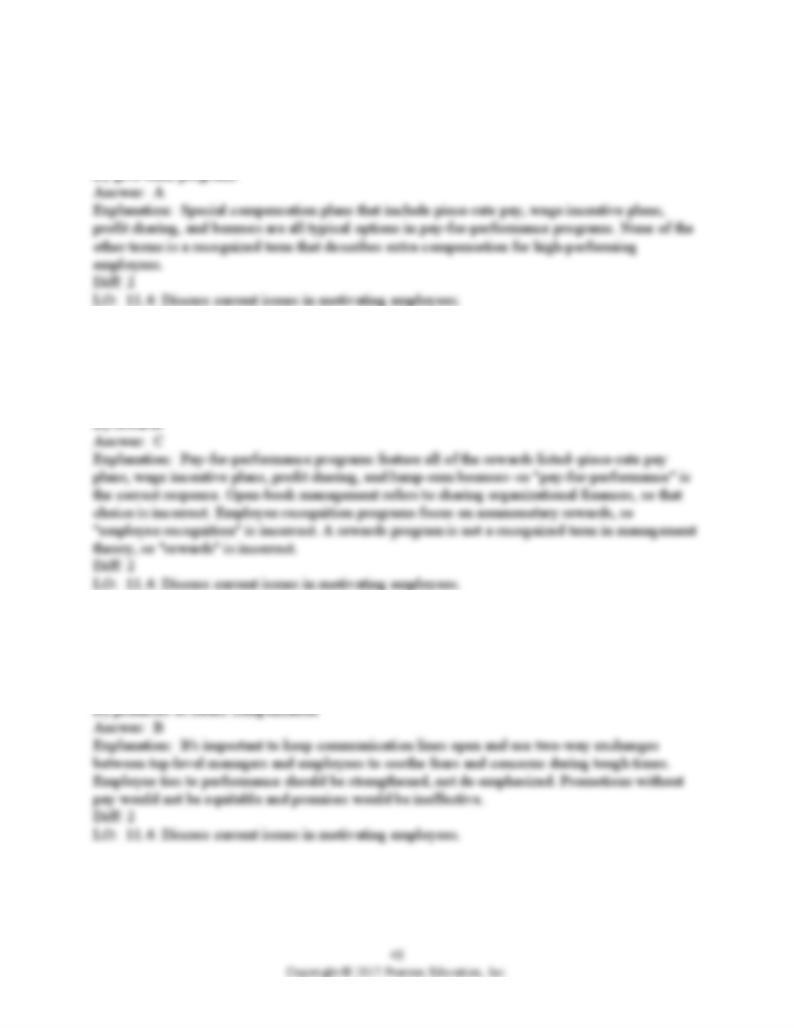
143) Compensation plans based on employee output or productivity are referred to as ________.
A) pay-for-performance programs
B) prize time programs
C) equity plus methods
144) Piece-rate pay plans, wage incentive plans, profit sharing, and lump-sum bonuses are
examples of ________ programs.
A) open-book management
B) employee recognition
C) pay-for-performance
145) During tough economic times, managers find that ________ work(s) best for motivating
employees.
A) de-emphasizing how employees work is tied to performance
B) fostering two-way communication
C) promotions in job status without increased pay
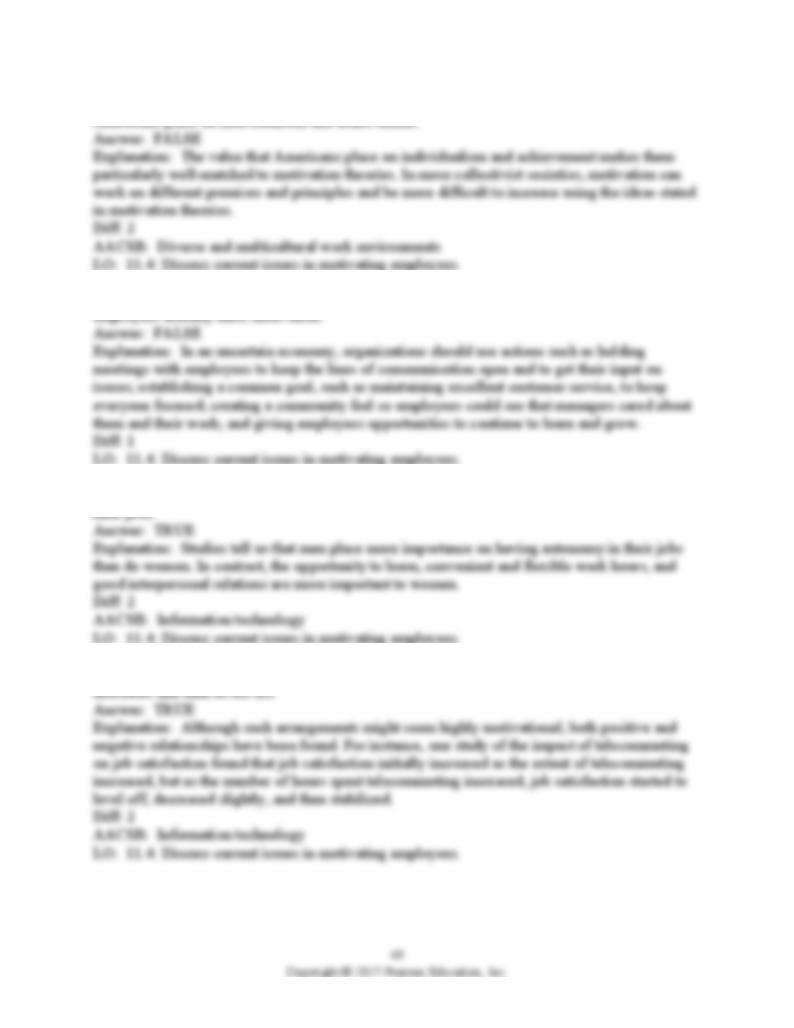
146) Motivation theories do not work well in U.S. organizations because of the emphasis
147) During tough economic conditions, communicating and sharing more information with
148) Research shows that men and women value different levels of flexibility and autonomy in
149) Telecommuting has been found to initially increase job satisfaction, but later satisfaction
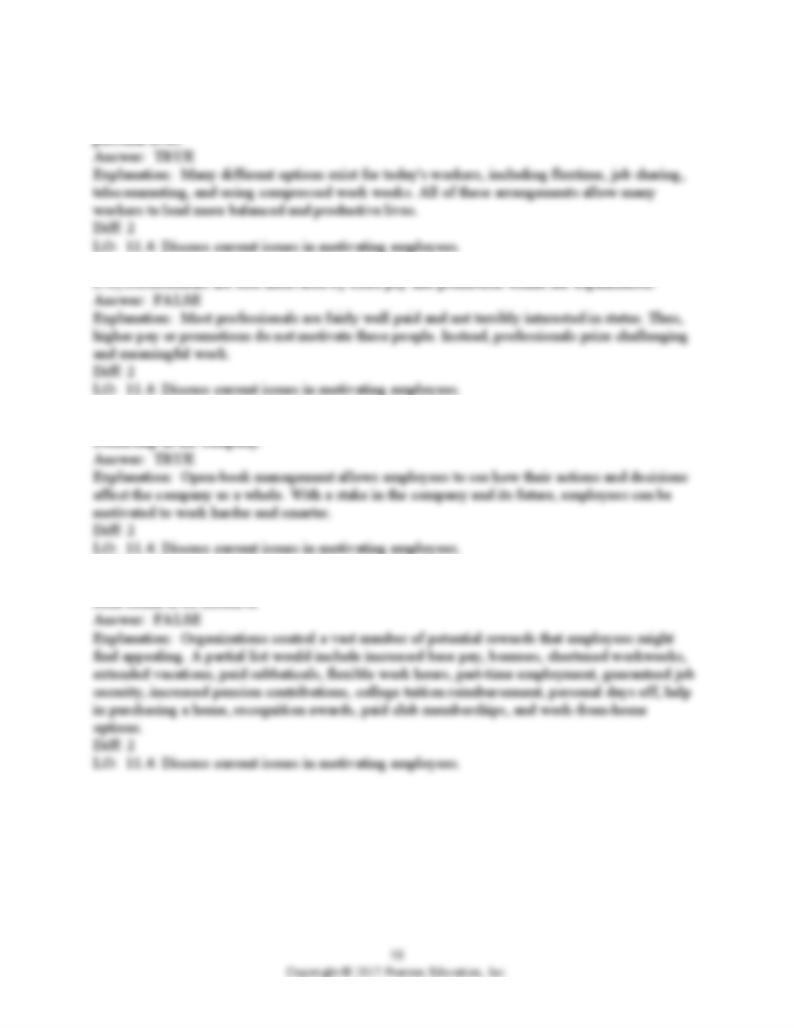
150) Today's workplaces provide a wide range of scheduling options and benefits that allow
employees more flexibility at work and allow them to better balance or integrate their work and
152) Open-book management programs motivate by giving employees a greater sense of
153) When it comes to using rewards to motivate employees, money is the only option that has
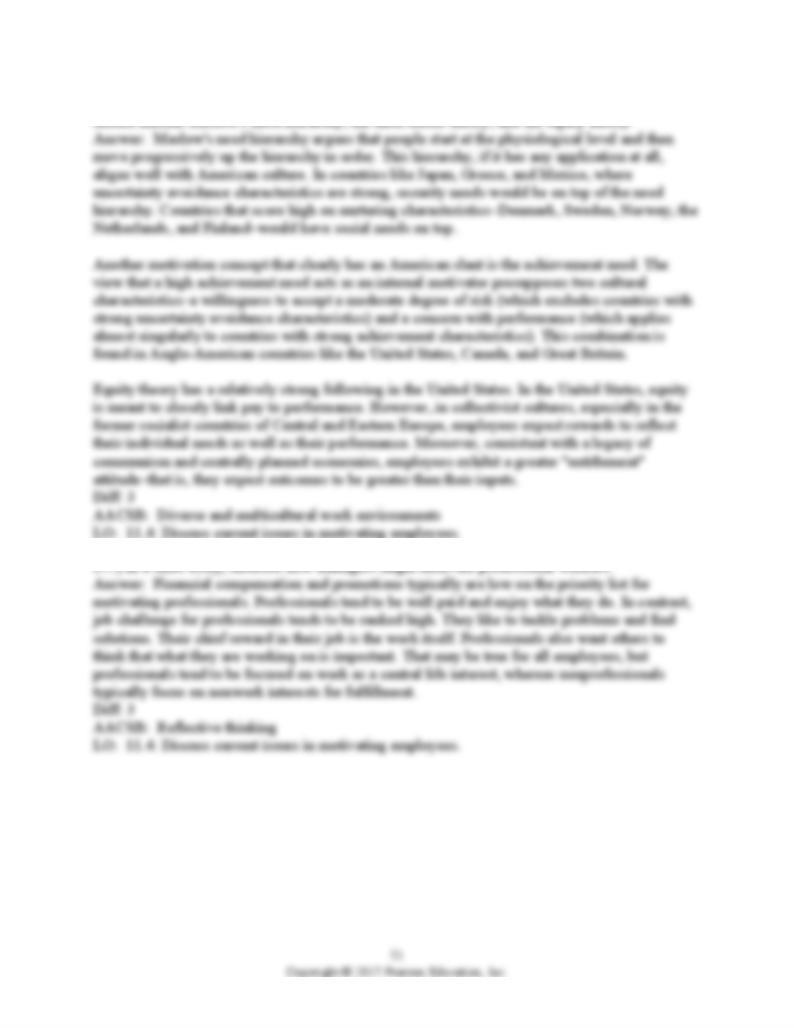
154) In a short essay, explain which theories work best for certain cultures. The discussion
